Home Blog Business A Guide to Organizational Change Management for Leaders

A Guide to Organizational Change Management for Leaders
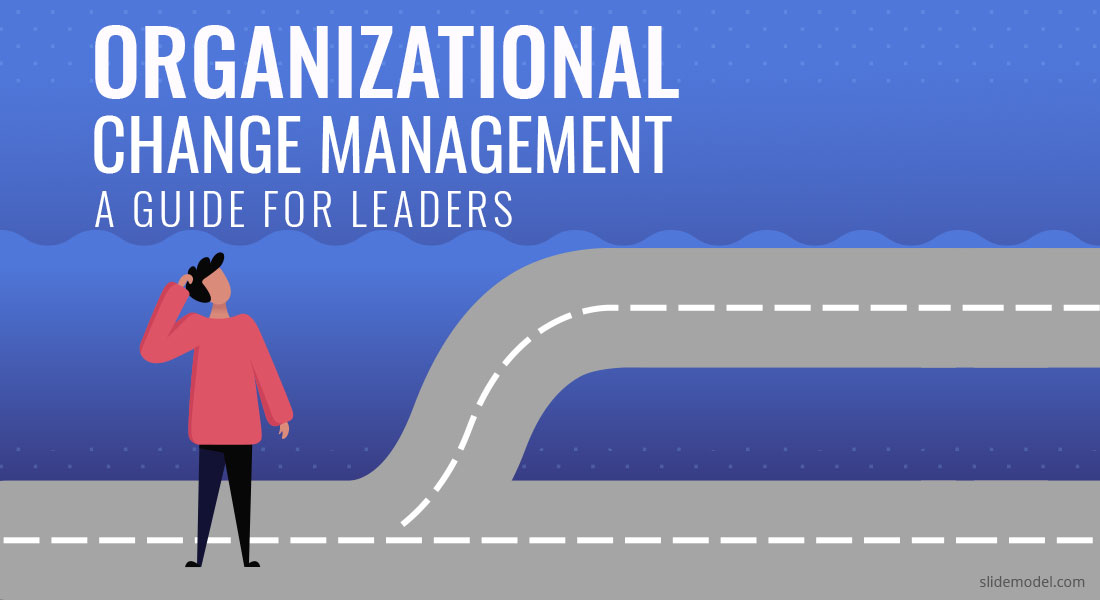
Nearly 7 in 10 business leaders have experienced at least one corporate crisis in the past 5 years — with the average number of crises, handled by them being three. And that’s even before 2020 has rolled it. So it only makes sense why business leaders today are increasingly focused on getting better at organizational change management.
What is Change Management?
SHRM defines change management the following way:
Change management is the systematic approach and application of knowledge, tools, and resources to deal with change.
In essence, the purpose of change management is to determine, structure, manage, and execute any initiative that would challenge the current status quo . The change management process includes multiple steps and structural elements, aimed at ensuring that:
- The organization can adapt/react to the changes, prompted by external conditions (e.g. market turbulence).
- The people, employed by the company, can go along with the proposed internal changes, prompted either by an internal or external need.
Change management is a cross-functional action, leaders pursue when they want to drive sustainable transformations and effective decision making across their organization with minimal resistance and disruption.
What is Organizational Change Management?
Organizational change management is a more narrow scope of action, aimed at altering how the organization operates. Organizational change can assume improvements in the company’s culture, standard operational procedures, service or technology portfolios.

The need for organizational change can be prompted by different factors such as:
- A slow rate of innovation
- Low operational efficiency
- Shift to another business model (e.g. from sales-led to product-led growth ).
Why is change important? The global pandemic is a good illustration. Agile companies, capable of pivoting and driving organizational changes fast (and effectively), ended up among the market movers. Whereas more reluctant or ineffective companies are still struggling to shake off the disruptive impact of COVID-19 on their operations.
Certainly, a ‘swan’ event such as the global pandemic is a more rare case of organizational change. Far more frequently, businesses introduce a change management policy as a response to the following types of changes:
Adaptive changes — small-scale, incremental changes leaders pursue as the company’s needs and priorities evolve. In most cases, such changes are slight adjustments to existing processes, planned out in advance along with other initiatives on the annual/monthly agendas. These may apply only to certain people, processes, or tech, rather than the company as a whole
Transformational changes — large-scale, radical initiatives, involving multi-vector transformations. For example, a shift in the company vision can require changes in the product portfolio, management, team structure, and business processes.
Due to the sweeping scale and vast impact, transformational changes required careful orchestration. Typically, such organizational change management strategies are put in place as a response to a major shift in market conditions, a disruption in the supply chain, or another major event.
Transitional changes — a group of ‘sub-changes’ aimed at taking the company from its current state towards the desired to-be to solve a particular issue. For example, after M&A the parent company will develop a change management plan, aimed at aligning operations within the purchased asset with the rest of the organization.
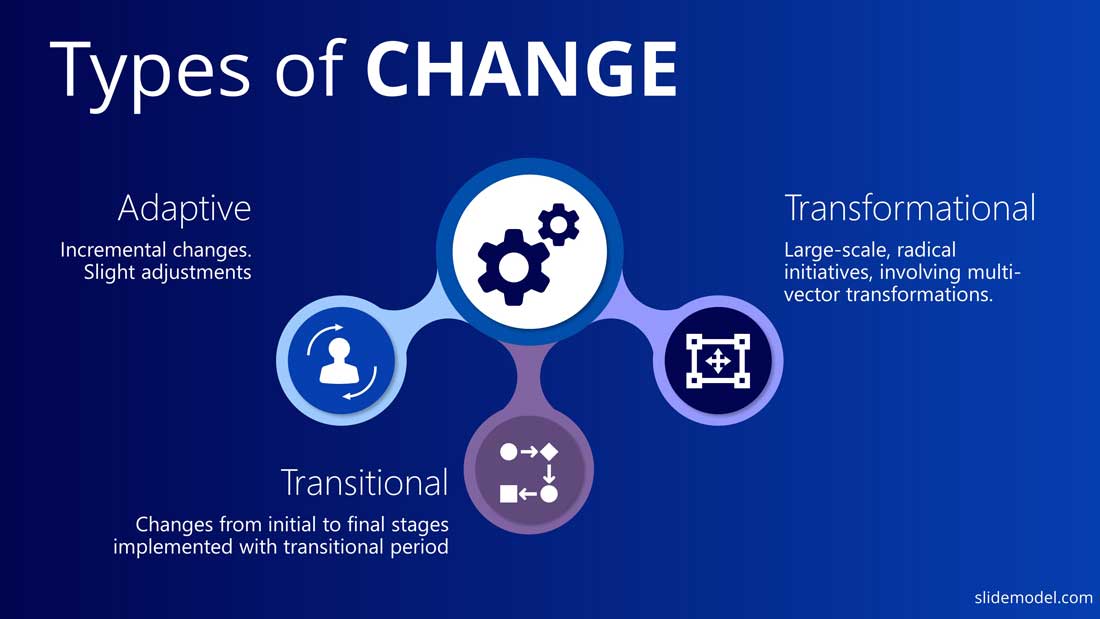
Organizational Change Examples
- Implementation of new technology or digital transformations
- M&A activity, company group consolidation
- Change in company leadership and strategic priorities
- Change in organizational culture
Popular Change Management Models: Overview
Old habits die hard. We are reluctant to change our usual ways, especially when the request for change is imposed on us (rather than manifests internally). That’s why formal change management techniques exist in the first place. They facilitate a paced and non-disruptive introduction of new practices, address resistance, and minimize turbulence, experienced during the change period.
But given that change comes in different shapes (and manifests as a response to different stressors), there is a range of change management tools leaders can leverage.
Kotter’s Change Management Theory
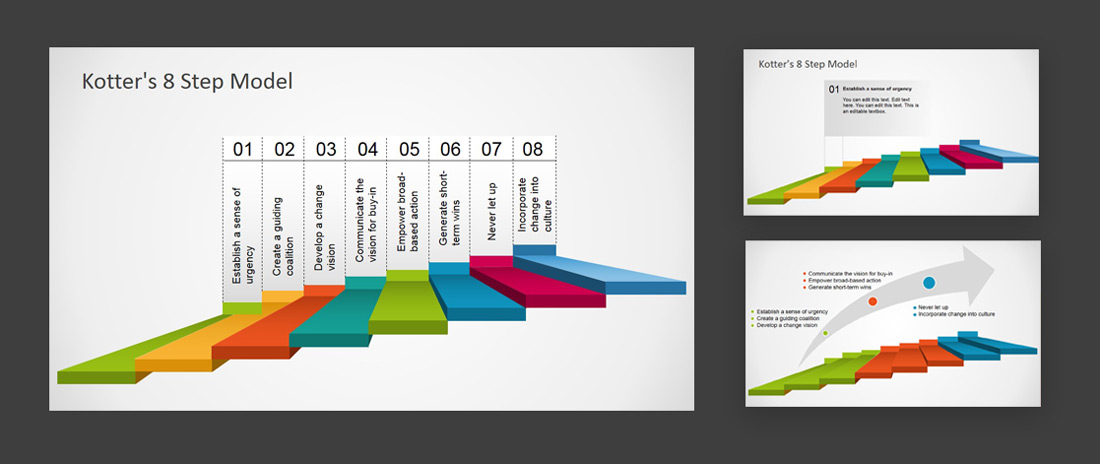
Dr. John Kotter, an author, and professor of Leadership at the Harvard Business School developed an 8-step framework for leading change. Each of the proposed change management steps is aimed at mobilizing the people around the purpose of change, getting a unified buy-in, and ensuring fast-paced action.
McKinsey 7-S Framework
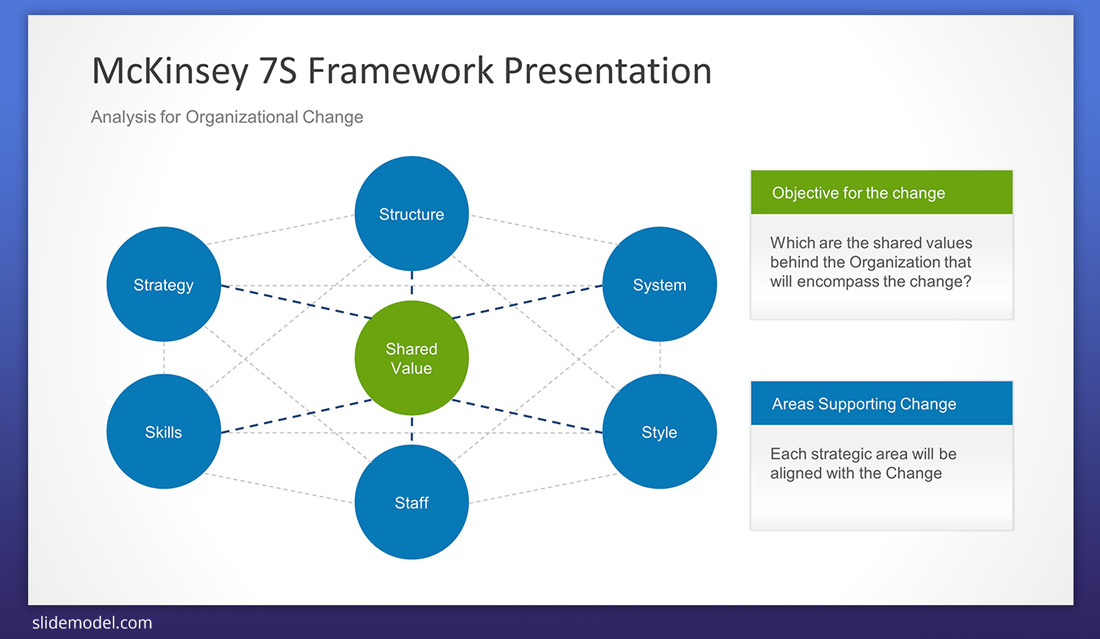
This change management model identifies 7 strategic areas, companies need to focus on in order to sustainably transform. These include:
- Strategy – a step-by-step roadmap for executing proposed changes.
- Structure – the company’s current structure and desired future state of it.
- Systems – new systems that will be required to support new operations.
- Shared values – core values and main principles that the company adheres to.
- Style – approach in which the change is adopted.
- Staff – current workforce composition and new roles that will become in demand.
- Skills – Competencies, possessed by the current workforce.
ADKAR model
ADKAR is an acronym for awareness, desire, knowledge, ability, and reinforcement — the five main components of effective change management, according to Jeff Hiatt. This model provides a great framework for formalizing the scope of change and identifying ways to support the employees during the transition.
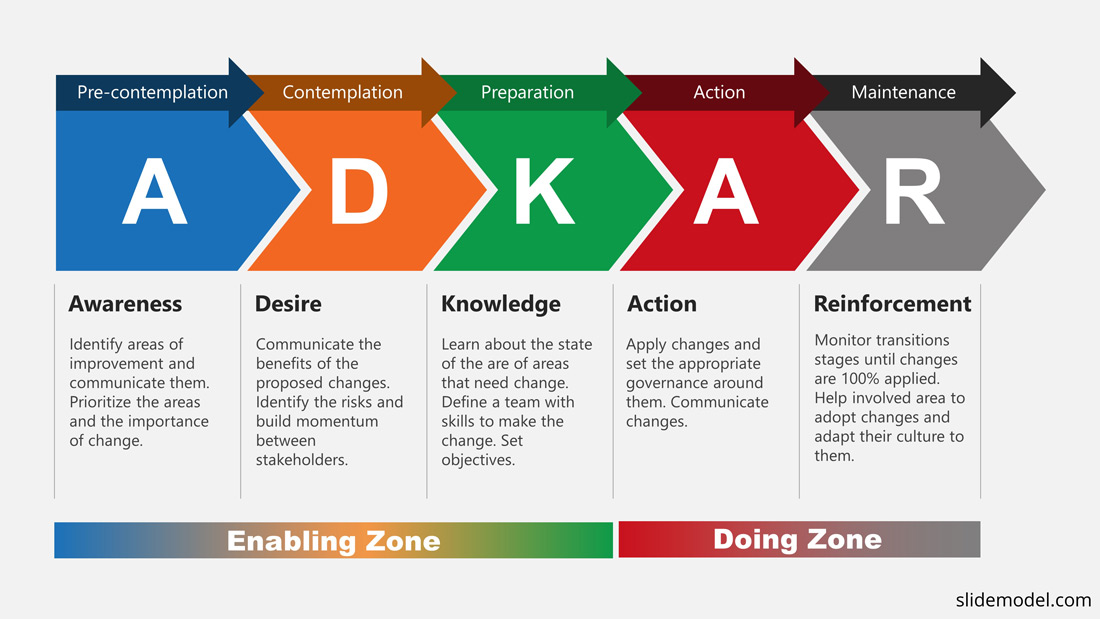
Lewin’s Change Management Model
This model focuses on helping leaders pursue stages in three phases:
- Unfreeze — a prep stage, aimed at ‘activating’ employees to make them more receptive to the imposed changes.
- Change — the active phase where change is introduced.
- Freeze — concluding stage, where all employees have adopted the change and can go back to a more ‘passive’ state of day-to-day activity.
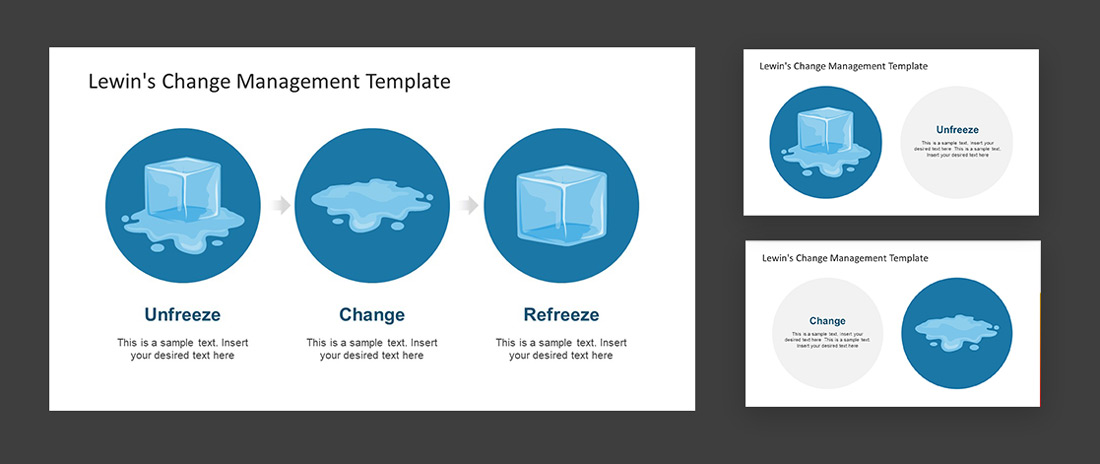
Organizational Change Management Best Practices
Organizational change and development is a multi-step process, requiring strong employee and stakeholder engagement .
To succeed with change management, leaders need to focus on the next 4 actions:
- Change Planning
Change Leadership
Change management, change maintenance, change planning .
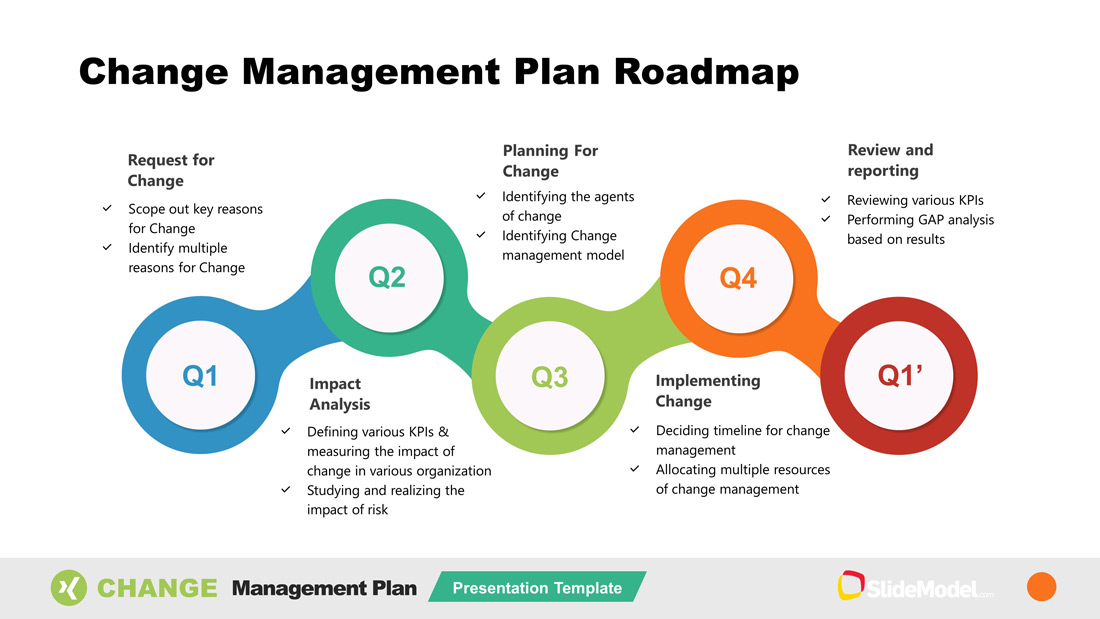
As the name implies, at this stage leaders analyze the current state of affairs, refine their vision, define future goals, analyze risks, and put plans for change.
To succeed with subsequent implementation, leaders need to:
- Create a detailed roadmap of change
- Set measurable and realistic objectives
- Identify success measurement
- Analyze and address possible risks
- Create a preliminary timeline for execution
- Set milestones and checkpoints
Best practices:
- Honesty and transparency: Prepare to have conversations with other leaders, stakeholders, and employees regarding the current state of affairs and the underlying needs for change.
- Regular conversations with the employees: To secure buy-in, communicate early and frequently with your people in regards to your plans, goals, and potential scope of change.
- Seek opinions from your teams. Gain grassroots support by having conversations with staff at different levels. Taking the planning conversations outside of the boardroom can help you gain fresher perspectives, and yet again — secure faster buy-in.
In most companies, change happens from the top-to-bottom. Yet, directions issued from the above can be rather unsettling for people at lower levels and create unnecessary tensions, or worse — outright resistance. To prevent such scenarios, ensure that you are listening to people at all levels and obtain their support.
Outstanding change leadership involves the ability to communicate appropriately with others — motivate, engage, influence, and reassure people of the positive impact of upcoming changes.
- Address and resolve concerns early: Understandably, some of your employees may resist change or otherwise feel threatened by it. Talk to such people. Provide them with reassurance and extra information in regards to the impact of change.
- Communicate status updates regularly: To facilitate faster adoption and alignment, provide plenty of information — update your company practices, provide status updates, schedule training if necessary.
- Assume a position of a servant leader: Servant leaders assume a supporting position and act as ‘facilitators’. They empower, support, and emphasize with their people and rally them around the shared cause.
The change management stage is all about overseeing how the people, processes, systems, and other moving parts contribute to the end goal of change. This phase will require the most targeted actions as leaders will need to constantly monitor progress and rapidly react to the slightest deviations on the change management timeframe. At this point, you should be focused on ensuring that:
- Changes are implemented sustainably, according to the plans.
- Risks are identified early and mitigated.
- Communication happens frequently
- Encourage knowledge sharing: Ask the early adopted to facilitate others with jumping on the new best practices. Create and support peer-to-peer learning opportunities and remove bottlenecks in information flows when those arise.
- Provide training: Some people will require upskilling to thrive in the new environment. Put plans for formal training initiatives.
- Recognize and reward: Make positive behaviors stick by recognizing change pioneers. At early stages, external motivation can be crucial to help with the development of intrinsic motivation later down the road.
Change maintenance is the final stage of the transformations. At this point, your main goal is to ensure that the change is successfully implemented and all the initiatives on the roadmap are finished. Focus on reinforcing positive behaviors, addressing remaining inefficiencies, and facilitating the people to reach a productivity plateau within the new environment.
The conclusion of this change is when the proposed change is fully transferred and embedded within your organization.
Best practices :
- Schedule an after-action review: To better reflect on the entire change management process and its success/shortcomings, schedule follow-up AAR meetings with your team.
- Create evaluation plans: To better monitor and evaluate the state of change, set extra milestones — short evaluation sessions, held every 3 or 6 months, during the first year — where your team analyzes the set success metrics and brainstorms ways to strengthen change.
To Conclude
Every organization, at some point, will undergo a transition or change. Whether prompted by external market conditions or internal processual inefficiencies, the scope of changes can have a major impact on the company’s viability. While organizational change management isn’t an easy process, you now know the main change management principles, models, and frameworks for orchestrating it effectively!
If after this article, you want to learn more about change management models visit our recent blog post on Proven Change Management Models .
1. Organizational Change Management Plan
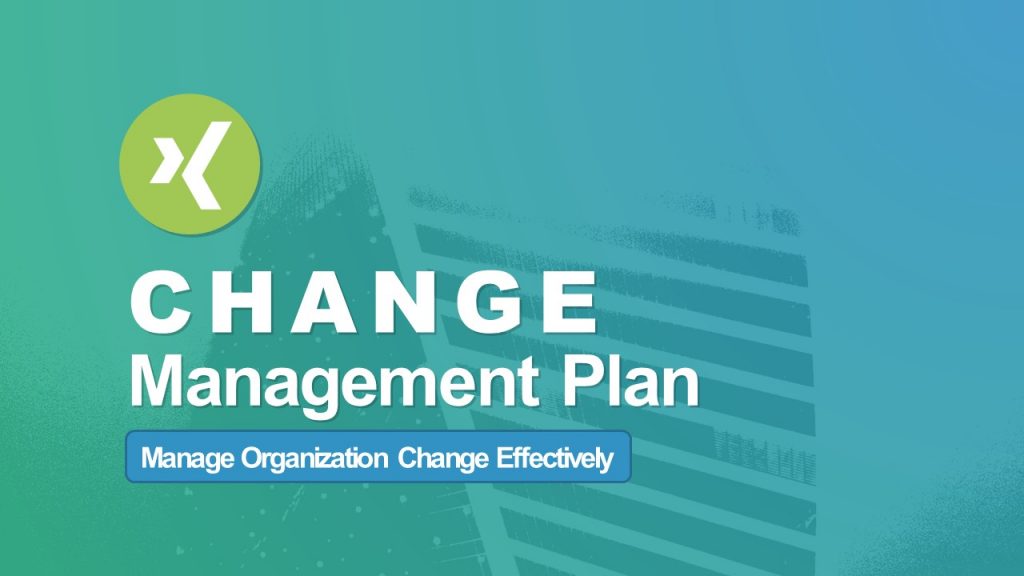
Change management is now more than ever a challenge to organizations of all sizes. This is why having an orderly, well-organized plan will make an absolute difference for any team when heading to implementation. In this template, you will find the diagrams and formats that will support you in building and transmitting your change management strategy’s key facts.
Use This Template
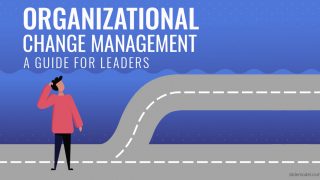
Like this article? Please share
Change Management, Leadership, Management Filed under Business
Related Articles
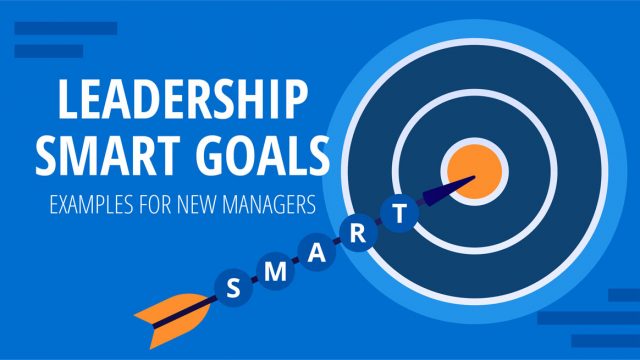
Filed under Business • April 23rd, 2024
7 Leadership SMART Goals Examples for New Managers
As a leader setting growth goals is one of the priorities at work. In this article we present Leadership SMART Goals Examples to guide your team to success.
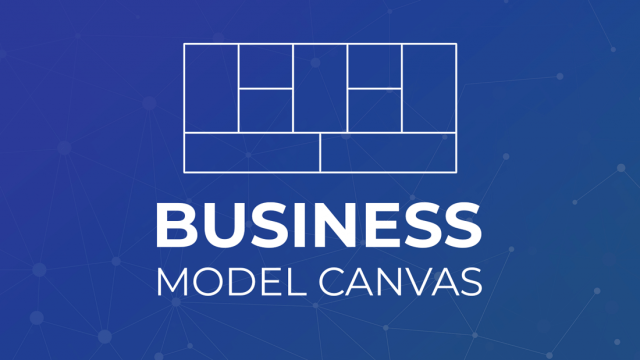
Filed under Business • September 11th, 2023
What is a Business Model Canvas? Quick Guide + Examples
A Business Model Canvas is a diagram used to visualize a business model. Learn how to make a Business Model Canvas with Examples.
![presentation change management How to Implement Kotter’s 8-Step Change Model [With Examples]](https://slidemodel.com/wp-content/uploads/00_kotter-change-model-cover-640x360.png)
Filed under Business • July 10th, 2023
How to Implement Kotter’s 8-Step Change Model [With Examples]
Let your organization reach its true potential by embracing the teachings from the Kotter’s Change Model, a roadmap for meaningful transformations.
2 Responses to “A Guide to Organizational Change Management for Leaders”
Thanks for the article, simple and a lot of insight.
good information and reliable
Leave a Reply

Powerpoint Templates
Icon Bundle
Kpi Dashboard
Professional
Business Plans
Swot Analysis
Gantt Chart
Business Proposal
Marketing Plan
Project Management
Business Case
Business Model
Cyber Security
Business PPT
Digital Marketing
Digital Transformation
Human Resources
Product Management
Artificial Intelligence
Company Profile
Acknowledgement PPT
PPT Presentation
Reports Brochures
One Page Pitch
Interview PPT
All Categories

Change Management Powerpoint Presentation Slides
Every organization needs to adapt to the ever-changing business environment. Sensing this need, we have come up with these content-ready change management PowerPoint presentation slides. These change management PPT templates will help you deal with any kind of an organizational change. Be it with people, goals or processes. The business solutions incorporated here will help you identify the organizational structure, create vision for change, implement strategies, identify resistance and risk, manage cost of change, get feedback and evaluation, and much more. With the help of various change management tools and techniques illustrated in this presentation design, you can achieve the desired business outcomes. This business transition PowerPoint design also covers certain related topics such as change model, transformation strategy, change readiness, change control, project management and business process. By implementing the change control methods mentioned in the presentation, you will be able to have a smooth transition in an organization. So, without waiting much, download our extensively researched change management framework presentation. With our Change Management Presentation slides , understand the need for change and plan to go through it without any hassles.
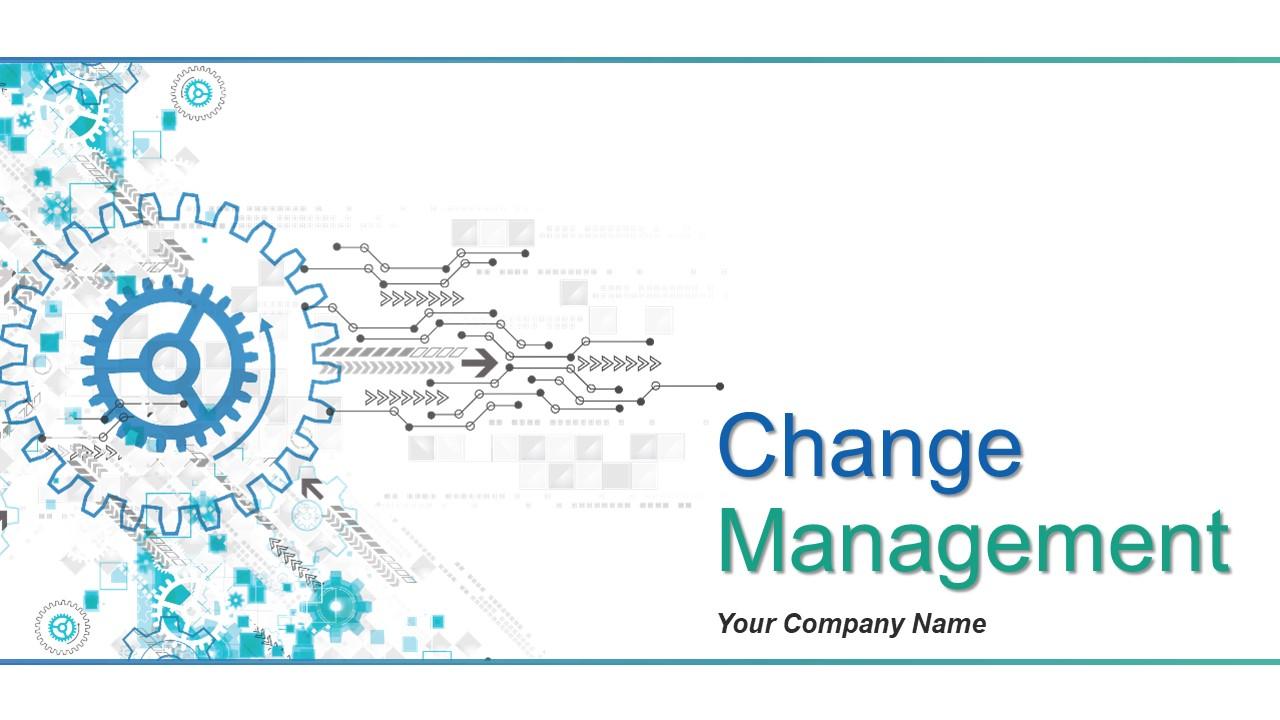
- Add a user to your subscription for free
You must be logged in to download this presentation.
Do you want to remove this product from your favourites?
PowerPoint presentation slides
Presenting change management PowerPoint presentation slides. This deck contains 74 uniquely designed slides. Our PowerPoint experts have included all the necessary templates, designs, icons, graphs and other essential material. This deck is well crafted by an extensive research. Slides consists of amazing visuals and appropriate content. These PPT slides can be instantly downloaded with just a click. Compatible with all screen types and monitors. Supports Google Slides. Premium Customer Support available. Suitable for use by managers, employees and organizations. These slides are easily customizable. You can edit the colour, text, icon and font size to suit your requirements.

People who downloaded this PowerPoint presentation also viewed the following :
- Business Slides , Flat Designs , Complete Decks , All Decks , Change Management , Management , Proposals , Operations , Strategy , Strategy Proposal , Management , Change Management
- Change Control ,
- Change management ,
- Business process
Video for Change Management Powerpoint Presentation Slides
Content of this powerpoint presentation.
Slide 1 : This slide displays the heading Change Management with a creative gear image. State your company name below and introduce change management structure. Slide 2 : This slide covers Table of Content for the presentation. It includes the following sub headings- Identify the change, vision for change, change management agents and framework, resistance and risk, implementation strategies, cost of change, feedback and evaluation. It also shows an imagery of contents to go with the text. Slide 3 : This slide expands the heading- Identify the Change. It showcases the type of change, forces, vision, organization change readiness, and Gap Analysis for the change required. Slide 4 : This slide shows Types of Change Management. The parameters displayed are- Systematic, Project and Organizational. State your Description, Used for and Impacted entities, by this slide. Slide 5 : This slide covers the forces for change in the organization/company. The forces enlisted are- Knowledge economy, Digital convergence, New Technology, Privatisations, Socio-cultural & political-legal reasons, electronic commerce and mergers & acquisitions. Slide 6 : This slide covers imagery for defining your Vision. It also contains text boxes with a creative glacier image. State your vision in terms of- ‘Where you are’ v/s ‘Where you want to be’ with the help of the segmented glacier image. Slide 7 : This slide displays Define your Vision with another variation. Showcase it in 5 steps your vision statement. State your vision in terms of ‘Where you are’ v/s ‘Where you want to be’ with accompanied steps. Slide 8 : This slide covers Gap Analysis. Address current state, gap and future state on the parameters of what, when, where, who and how. Showcase your analysis with the help of this table in details. Slide 9 : This slide displays the checklist for Organization Change Readiness. State Deliverables, Implementation Team leader and Sponsor with this slide. Display People readiness of the organization in terms of Business unit/Product Group Actions and Training with Action required for the particular parameter. You can also show the time and duration of the change under the headings- ‘When’, ‘Completed’. Slide 10 : This slide displays the checklist for Organization Change Readiness. Showcase System Readiness in terms of ICT, Content and Business Application as parameters for tracking. State the Action required, and time duration of start and finish under the headings- ‘When’, ‘Completed’. Slide 11 : This slide covers Change Management Agents with a backdrop image of a businessman. The points included for agents are- Board, Sponsor, Leader, Team members and Stakeholders. Slide 12 : This slide displays Change Management Board with the following subheading members- Secretary, Finance manager, Service level manager, Change manager, Application manager, Problem manager, Business case representative and Release manager. It is shown in the form of a team table with manager imagery to go with each designation. Slide 13 : This slide showcases Change management sponsors with stakeholder and leadership as subheadings. State the stakeholder and leadership share in percentages with this slide. Slide 14 : This slide shows Role of Leadership in Change management. Accompanied with a bar graph, state contribution/role importance in terms of percentage. The subheadings included to show the percent count are- Vision, Energizing people, Communication, Charisma and Competence. It displays icon imagery for each of the sub headings included. Slide 15 : This slide shows the Role of team members. The subheadings that make it explicit are- Project Leaders, Release management role, Press co-ordination role, and Performance management role. It also includes imagery for each of the respective sub headings. Slide 16 : This slide covers Role of Key stakeholders. With a pyramidal image it displays the factors of- Driving, Advocacy, Active participation, Willingness, and Understanding. It also showcases imagery for each sub heading shown. Slide 17 : This slide shows Change Management Framework. With apt imagery to go with, it showcases Process, Plan, Tools and Models to fill the text for. Slide 18 : This slide shows Change management process. The process shown covers – Initiate the change request (Identify the change & all the particulars of the change), Planning (Identify the impact of changes, Anticipate and mitigate the risks Develop implementation & release strategies), Review by Change Request Board (Change request board reviews change request, CRB selects the process map based on the change request, CRB routes the plan for necessary approvals), Implementation (Rollout changes, Allocate resources, Communicate changes, Align system, structure & policies), Review (Evaluate the effectiveness of the changes ,Review the areas of resistance, and prepare strategies to manage it), Sustain Maintain momentum, Apply methods for continuous improvement). The change management process is the sequence of steps or activities that a change management team follow to drive change management. Slide 19 : This slide showcases a Change Management Plan. A basic plan defines activities and roles to manage and control change during ‘execution’ and ‘control stage’ of the project. Basic structure has been shown in this slide. Slide 20 : This slide shows Change Management Tools such as- Job Impact Assessment, (Ascertain the impact of change on roles & people), Stakeholder Analysis, (Identify stakeholder engagement levels for mutual solutions), Change Impact Assessment, (Identify potential impact of change on the organization), Change Effectiveness Assessment, (Determine the need to re-evaluate the current approaches to ensure sustainability of change), Change Readiness Assessment, (Diagnose AS-IS situation & evaluate the employee readiness towards the change). Slide 21 : This slide showcases Change management Models. Various models used in change management process have been listed down. You can choose one or more models based on your requirement- The Burke-Litwin Change Model, The Johari Window, Kotter's Eight Phases of Change, The ADKAR Change Model, The McKinsey 7S Framework, Leavitt's Diamond, Lewin's Three Stage Change Model, Bridges' Transition Model, Change Curve Model. Slide 22 : This slide shows Lewin's Three Stage Change Model. We have mentioned a framework of Lewin’s three stage model. Unfreezing- Readiness to change Educate (everyone understands) Inform (what, why, when, how) Consult (seek views & ideas, allow thinking time, use others’ ideas), Plan (objectives, resources, time-scales, measures, budgets) Organise (work plans) Appoint (leaders, managers, teams) Changing- “Implementation” Praise, Encouragement, Recognition & empathy Coach, Train, Lead Manage Help & guidance, Regular feedback, Provide adequate resources. Refreezing- “Making it Stick” Set performance indicators Monitor & evaluate performances, Establish systems to make it happen, Establish controls to check it is happening, Rewards for new behaviour Sanction (or lack of reward) for old behaviour, A period of relative stability (consolidate). Slide 23 : This slide shows ADKAR MODEL. The headings showcases- Phases of a Change Project, Phases of Change for Employees, Awareness, Desire, Knowledge, Ability, Reinforcement, Implementation, Post - Implementation, Concept & Design, Business Need. Slide 24 : This slide shows framework of Bridge Transition model. Bridge Transition Model covers- Ending, Transitions, New Beginning, Uncertainty, Exploration, Skepticism, Commitment. Slide 25 : This slide showcases Szpekman's Communication Framework. The headings covered are- Communication (Communication Plans, Print & Electronic Media, Face-to-Face Communication), Leadership, (Vision & Strategy Agenda, Items Questions, Praise, Resources, Assignments, Symbolic Behavior) Structure / Process, (Organization Structure, Career Paths, Policies & Procedures, Roles & Responsibilities, Tools & Support) Rewards, (Compensation Plans, Benefits, Recognition Programs, Promotions) Measures, (Performance Management, 360 degree Feedback, Employee Surveys Performance Metrics & Benchmarks) Knowledge / Skill Emphasis, (Competency Models, Hiring Processes, Orientation Programs, Training & Development, Feedback & Coaching, Talent Planning) Slide 26 : This slide showcases Roger's Technology Adoption Curve. The main headings constitute of- Innovators, Early Adopters, Early Majority, Late Majority, Laggards to be shown with respective percentages. Slide 27 : This slide covers Risks and Barriers. The subheadings include- Risk Assessment, Resistance to Change, Resistance Management Plan Slide 28 : This slide covers Risk Assessment in details. Identify the risk and assess the significance and likelihood of it occurring and plan the contingency. For effectively change management process, it is important to identify all the possible risk elements associated with it. Date of risk occurring and Brief Description of Risk, Mitigation Action, Approval of Commencement, Date of Commencement, Risk No. can be shown by with respective High medium low parameters. Slide 29 : This slide displays Risk Matrix. It is a detailed variation of Risk associated in Change management. Consequences in the order of Insignificant, Minor, Moderate, Major, Catastrophic factors for any Likelihood to happen can be shown by this matrix. Slide 30 : This slide covers Resistance Assessment Survey. For the smooth implementation of change, it is important to identify all the barriers. The Areas, Description and Rating can be shown in terms of list of potential areas for resistance that you may be experiencing in the implementation of the SLM project. For each area indicate the degree to which you agree or disagree by placing your response in the box from the following scale. Assess the across individually and highlight any scores that are greater than three. This area should then become your primary focus for the greatest resistance to your project are- Area of Resistance, Description, Rating. Slide 31 : This slide shows Resistance to Change faced. For the smooth implementation of change, it is important to identify all the barriers. You can rate all the possible barriers and analyse which barriers needs to be dealt first. The following factors can be gauged on the parameters of High medium low- Inadequate Team & Users Skills, Technology users not involved, Resistance to Change, Limitation of Existing System, Lack of Executive Commitment, Lack of Executive Champion, Unrealistic Expectation, Lack of Cross-Function Team, Project Charter Too Narrow. Slide 32 : This slide is another variation of Resistance to change faced. These factors can be gauged on the parameters of High medium low. Slide 33 : This slide covers Resistance management plan in brief. It shows Resistance management plan which includes Key areas, Actions and persons responsible. Slide 34 : This slide displays Implementation Strategies. The sub headings include- Change Transition Plan, Communicating the Change, Change, Management Training, Sustaining the Momentum, Timeline for Implementation. Slide 35 : This slide showcases Change Transition plan for milestones covered in a span of twelve months. Management Owner (Preparation), Communications Owner (Announcement), H.R Owner (Grievances, New Positions) Staff Relocation Owner (Team 1) IT Owner (Telecoms/PC) Slide 36 : This slide shows Change Transitions plan. This a Gantt chart representing various tasks to be performed along with their duration and degree of completion. Slide 37 : This slide covers Change Transition Curve. This curve depicts the transition process at different time intervals. Numbness, Denial, Panic Dread, Acceptance Acknowledgement, Testing & Experimentation, Feelings of optimism Hope Renewed Energy, Feelings of satisfaction, Shock Sudden Awareness, Blaming Self Blaming others, Depression Insecurity, Discovery & Learning, Integration & New meaning, These aspects are covered in terms of Time and Performance. Slide 38 : This slide displays Communication Plan. The table can be used to prepare plan for communicating the change to the employees. Audience, Key Messages, Delivery Methods, Date, Length of Session (if applicable), and Location are the major factors covered which can be presented. Slide 39 : This slide presents a table which can be used to prepare plan for communicating the change to the employees. Communication Plan (Option 2 Of 2) contains the same parameters in a different colour variation. Slide 40 : This slide represents Communication Tools Matrix. The main sub headings included are- Industry, Corporation, Groups,Individuals All the above mentioned points are divided on the basis of Soft skills and Hard skills respectively. Slide 41 : This slide shows Change Management Communication. Various channels for communicating change has been listed down. Channels under direct control of management are sub divided into- Face to face Options, Department Meetings One-o-one meetings, Town Hall Meetings, Brown Bag Lunches, Training courses and workshops Alternate under direct control of management Emails Corporate Newsletters FAQs Internal Memos Posters Intranet Channels Not Under Direct Control of Management Market Place Changes Customer Inputs Slide 42 : This slide is another variation of Change management communication. Slide 43 : This slide consisting of a Change Management Training table can be used to prepare plan for training and educating the employees. Slide 44 : This slide shows Change Management timelines for 6 months. Its sub headings are- Shared (Change Purpose), Visible (Change Leadership), Smart (Engagement & Communication), Strong (Individual Performance), Supportive (Organization & Culture), Meaningful (Change Measurement). These sub headings can be categorised as Diagnosed, Design and Develop. The Diagnose section includes- Define Future State, Define Change Governance, Stakeholder Analysis, Knowledge & Skill Assessment, Culture Change Analysis, Business process Alignment. The Design and Develop section includes- Change Impact Assessment, Change Management Plan, Develop Change Leaders, Support Change Leaders, Build Change Network, Stakeholder Communication Effective, Performance Management, Effective Talent Management, Effective Training & Knowledge Management, Measure Change Progress, Assess Change, Readiness Behaviour Change Plan Prepare organization Design, Implement organization Design. Slide 45 : This slide is on Sustainability- an important factor in success and continuous improvement of change. Various methods for sustaining momentum has been listed. Sustaining Momentum slide includes - Building a Support System for Change Agents, Staying the Course, Developing new competencies & Skills, Reinforcing new behaviors, Providing Resource for change. Slide 46 : This slide displays Cost of Change Management as the main title. Slide 47 : This slide displaying Change Management Cost table helps you in ascertaining the cost incurred in executing various steps of change management process. It displays a quarterly cost table with the following headings and content- Task name and Cost to be covered under four quarters. Task name with its subheadings are- Top Down Plan, Strategy, Change Readiness Assessment, Execute Change, Long Term Sustainment. Put the cost involved in front of these sub headings as deemed fit. Slide 48 : This slide covers Feedback and Evaluation. The subheadings included are- Change Management Feedback Sustaining the Momentum Timeline for Implementation Change Management Experience Change Management Performance Dashboard Slide 49 : This slide shows Change Management Questionnaire / Feedback. This is an analysis carried out to capture the overall experience of the change management process. It is divided into Descriptor Section and Comments/Feedback section. Slide 50 : This slide shows the overall Results found out. The factors included are- Effective Leadership at all Levels, Strong Sense of shared purpose one that is Inspiring and Engaging, Strong Customer Focus, Employee Involvement and Support for Change, Commitment to Learning & Change, Speed of Delivery Balanced with Effective Governance, Understanding of the Impact of the Organization on Society. Slide 51 : This slide represents a graph for Change Management Experience. Overall Effectiveness of Change Management Program Poor -Fair -Good- Excellent. This is the parameter for the experience. Slide 52 : This slide displays Change Management Performance Dashboard. The factors calculated are- %Change Implemented within Target, %Changes Failed, %Emergency Changes, Average Change Implementation Time, %High Risk Changes, Average Cost per Change, %Change Rejected, for the entire Change Management Score. Slide 53 : This slide displays Change Management Icons. Slide 54 : This is another Change Management Icon Slide. Slide 55 : This slide shows Coffee Break image. Slide 56 : This slide displays the title Charts & Graphs. Slide 57 : This slide shows a Line Chart for two product comparison. Slide 58 : This slide shows a Line Chart for two product comparison. Slide 59 : This slide displays a Stock Chart with volume as parameter in terms of high and low, open and close. Slide 60 : This slide contains a Line Chart. Product 01Product 02 can be shown in comparison. Slide 61 : This slide is titled Additional slides. Slide 62 : This slide contains Our Mission with text boxes. Slide 63 : This slide helps depict Our Team with text boxes. Slide 64 : This slide helps show- About Our Company. The sub headings include- Creative Design, Customer Care, Expand Company Slide 65 : This is a representative image for using a QUOTE. Slide 66 : This slide is titled as Financials. Show finance related stuff here. Slide 67 : This slide shows Comparison of number of users and Time. Slide 68 : This slide shows Our Goals for your company. Slide 69 : This slide showcases a Puzzle with imagery. Slide 70 : This slide displays a Venn diagram image. Slide 71 : This slide shows Target image with text boxes. Slide 72 : This slide shows a Mindmap for representing entities. Slide 73 : This slide displays a Bulb or idea image. Slide 74 : This is a Thank You image slide with Address, Email and Contact number.
Change Management Powerpoint Presentation Slides with all 74 slides:
Your thoughts are adequately cared for by our Change Management Powerpoint Presentation Slides. They are excellent custodians.

The Change Management structure refers to a set of processes and strategies that help organizations manage and implement changes effectively. It can be introduced in a company by following the guidelines outlined in the presentation, starting with identifying the change and evaluating the organization's readiness for it.
The different types of Change Management are Systematic, Project, and Organizational Change Management. They are used depending on the scope and scale of the change initiative. Systematic Change Management is used for smaller-scale changes, while Project and Organizational Change Management are used for larger-scale changes.
The forces for change in an organization include factors such as the knowledge economy, digital convergence, new technology, and socio-cultural and political-legal reasons. They are important because they drive the need for change and can help organizations stay competitive and relevant in their respective industries.
Gap Analysis is a process that involves identifying the current state of an organization, determining where it needs to be in the future, and identifying the gaps that need to be bridged to get there. It is necessary because it helps organizations understand their strengths and weaknesses and develop a roadmap for change.
Some Change Management Tools that can be used include Job Impact Assessment, Stakeholder Analysis, Change Impact Assessment, Change Effectiveness Assessment, and Change Readiness Assessment. These tools can help organizations identify potential obstacles, evaluate the effectiveness of changes, and assess employee readiness for change.
Ratings and Reviews
by Mohamed Saleh
February 22, 2024
by Anh Phương
January 11, 2023
by teknik ptpn6
November 7, 2022
by aditya prayogi
October 26, 2022
by Chuck James
July 4, 2021
by Curtis Herrera
by DrSumaili85 DrSumaili85
April 26, 2021
by Amine Zaouali
January 19, 2021
December 6, 2020

Change management presentations: The all-in-one guide
Learn how to create effective change management presentations that engage your audience and help you achieve your goals.
Raja Bothra
Building presentations

Hey there, fellow presentation enthusiast!
If you're reading this, you're probably gearing up for a change management presentation.
Well, you're in luck because today, we're diving deep into the world of change management presentations.
Get ready to discover everything you need to know to ace your next presentation and leave your audience not just informed but inspired.
What is change management?
Change management is a concept that's become essential in today's ever-evolving business landscape. It's all about making strategic shifts within an organization while ensuring a smooth transition. Why? Because change is inevitable, but its success isn't. Companies that adapt effectively thrive, while those that struggle often find themselves facing a bumpy ride.
Reasons why change management initiatives fail
Now that we know the importance of change management let's explore why some initiatives hit a brick wall. The truth is, not all change efforts yield the desired results. Here are a few common reasons why:
- Resistance to change: One of the most significant roadblocks to change is resistance from employees. It's like trying to push a boulder uphill. We'll discuss strategies to tackle this later on.
- Lack of executive commitment: If the top brass isn't fully on board, it's tough to expect employees to embrace change wholeheartedly.
- Unrealistic expectations: Sometimes, organizations set the bar too high, leading to disappointment when results fall short.
- Inadequate team: Building a capable change management team is crucial. Without the right players, your strategy may crumble.
How to structure an effective change management presentation
Now that we understand what change management is and why it often hits roadblocks, let's get into the nitty-gritty of crafting a compelling presentation. Your presentation should be like a well-structured roadmap, guiding your audience through the change journey. Here's how you can achieve that:
- Introduction to change management: Start by defining change management. Explain why it's vital for organizations today. Make it crystal clear.
- The change management process: Dive into the step-by-step process of change management. It's like following a recipe – each ingredient plays a crucial role.
- Utilizing powerpoint templates: Presentation slides are your canvas. Explore how templates can make your presentation visually appealing.
- Understanding organizational change: Delve into the dynamics of organizational change. What drives it? What are the forces at play?
- Overcoming resistance to change: Address the elephant in the room: resistance. Share strategies to navigate this challenging terrain.
- Executing the change process: Break down the implementation phase. What steps should you follow to make it successful?
- The change management team: Introduce the key players behind change management. It's a team effort.
- Navigating current and future states: Discuss the transition from the current state to the future state. It's like crossing a bridge – a bit shaky but necessary.
- Identifying barriers: What obstacles might you face on your change journey? Identify and strategize.
- Engaging key stakeholders: Your stakeholders are your allies. How can you get them on board with the changes?
Do’s and don'ts for an effective change management presentation
Congratulations, you've mastered the structure of a compelling change management presentation. Now, let's delve into the critical do's and don'ts to ensure your presentation not only hits the mark but leaves a lasting impact.
Do's :
- Engage your audience : Start by captivating your audience's attention. Share relatable stories, use visual aids, or pose thought-provoking questions.
- Stay focused on the message : Keep your presentation laser-focused on the core message. Avoid veering off into tangents.
- Use visuals effectively : Incorporate compelling visuals to reinforce your points. A well-placed graph or chart can convey complex information with ease.
- Simplify complex concepts : Break down intricate ideas into digestible pieces. Your audience should leave with a clear understanding of the subject.
- Interact with your audience: Foster engagement by encouraging questions and discussions. Make your presentation a dialogue, not a monologue.
Don'ts :
- Avoid jargon : Steer clear of technical language or industry jargon that might alienate your audience. Speak in plain, understandable terms.
- Don't overload with information : Less is often more. Don't overwhelm your audience with a barrage of facts and figures. Focus on the most relevant information.
- Refrain from reading slides : Your slides are there to complement your presentation, not serve as your script. Avoid simply reading off them.
- Don't rush through : Take your time to explain concepts clearly. Rushing through your presentation can leave your audience bewildered.
- Steer clear of negativity : Maintain a positive tone. Avoid dwelling on the challenges of change; instead, emphasize the opportunities it presents.
Summarizing key takeaways
Let's take a moment to distill the wisdom you've acquired throughout this journey. Consider this section as your treasure chest of insights, a concise roadmap to guide you in your pursuit of mastery in change management presentations.
- Engagement is essential: Begin with a captivating introduction. Engage your audience from the start.
- Clarity is king: Maintain a singular message. Avoid tangents and information overload.
- Leverage visual aids: Use charts, graphs, and images. Simplify complex ideas and enhance understanding.
- Simplify complexity: Break down intricate concepts. Ensure a clear and uncomplicated understanding.
- Encourage interaction and dialogue: Foster questions, discussions, and engagement. Make your presentation a two-way communication.
- Avoid jargon: Speak in plain language. Keep it accessible and relatable.
- Quality over quantity: Focus on the most relevant information. Prioritize content wisely; avoid overwhelming your audience.
- Be the narrator, not the reader: Use slides as visual aids, not scripts. Engage through storytelling and explanation.
- Avoid rushing: Take your time for clarity. Don't rush through your material.
- Emphasize positivity: Highlight the opportunities that change presents. Maintain a positive tone throughout.
In conclusion, change management presentations are your ticket to successfully navigating organizational transformations. By following these guidelines and using Prezent, you're well on your way to becoming a change management presentation pro. Remember, change is constant, but with the right tools and knowledge, you can ride the waves of change with confidence.
1. What is the significance of using a change management powerpoint or change management ppt in presentations?
Utilizing a change management powerpoint or change management ppt is crucial for visually representing complex ideas. These presentations help convey the forces for change effectively. Visual aids simplify understanding, and you can easily download templates to streamline the process.
2. How do you ensure active manager involvement in the change management process?
Managers play a pivotal role in change management. To foster their involvement, align their objectives with the change plan's objective. Ensure they have the necessary support system for change agents and understand their performance management role in the transition.
3. What are the key phases of change in a change management plan, and how do you ensure a smooth implementation of change?
The phases of change typically include preparation, planning, execution, and evaluation. To ensure smooth implementation of change, focus on alignment with your team members, provide the required resources for change, and gauge the organization's readiness for change.
4. Can Google Slides be used effectively for change management presentations?
Absolutely, Google Slides can be a valuable tool. They offer collaborative features, making it easier to work on a change project. Just ensure they align with your change plan and conduct a gap analysis if needed to evaluate their suitability.
5. How can organizations maintain sustaining momentum during a change initiative, especially when facing restraining forces?
To maintain sustaining momentum, it's crucial to identify and address restraining forces effectively. This often requires strong sponsorship, a clear understanding of driving forces, and a commitment to learning and reinforcing new behaviors. Effective leadership at all levels is essential to navigate these challenges successfully.
Create your change management presentation with Prezent
Are you excited to put your newfound knowledge to use? We recommend using Prezent, the all-in-one AI presentation software for enterprise teams. With a library of over 35,000 slides, real-time collaboration, and brand-approved designs from Fortune 500 companies, Prezent can save you up to 70% of presentation creation time while keeping you 100% on brand.
So, go ahead, create a presentation that not only informs but inspires change. Good luck!
Ready to boost your change management presentations? Start with a free trial or book a demo with Prezent today!
More zenpedia articles

How to write a problem statement slide for PowerPoint
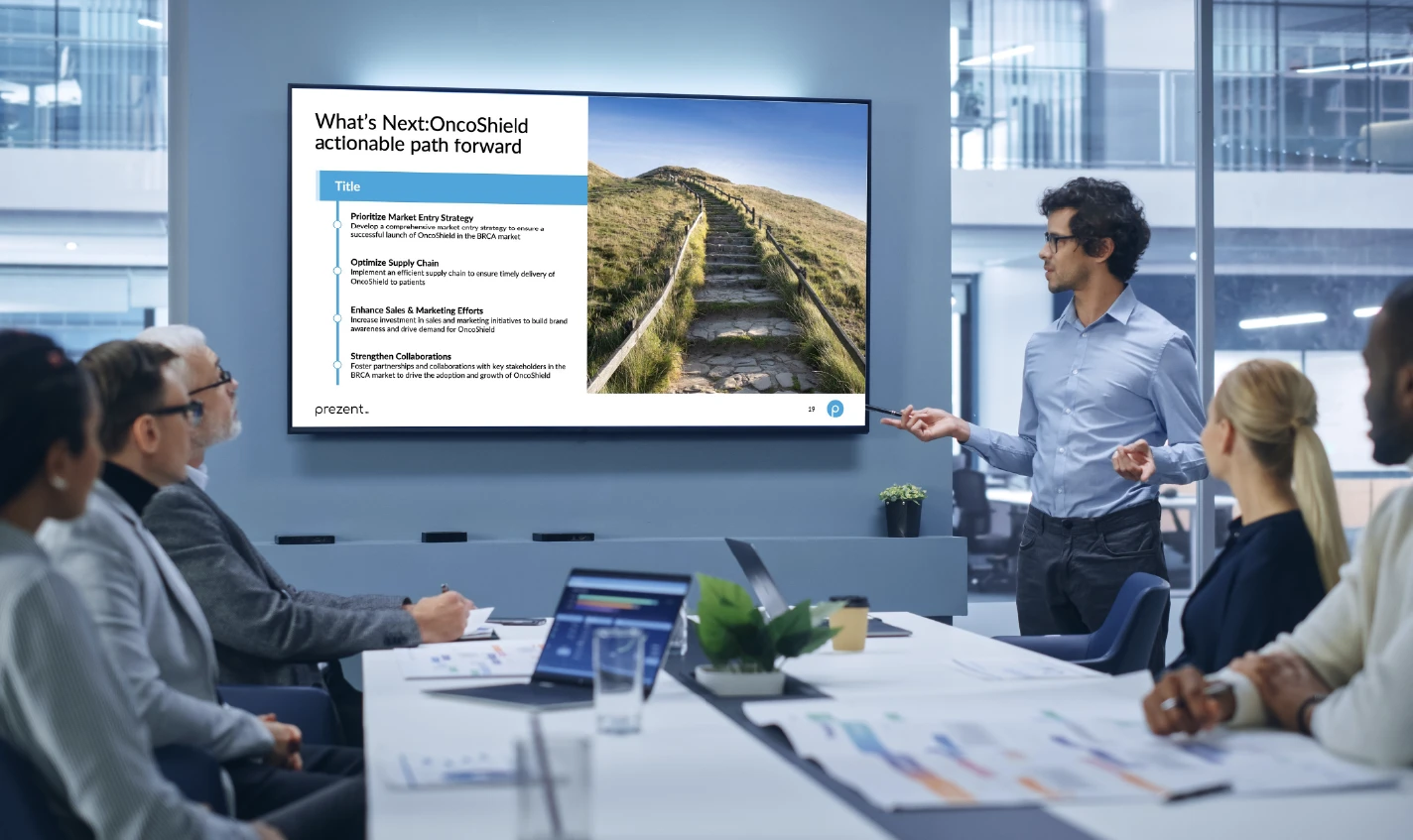
5 Effective and powerful ways to end a presentation!

7 Simple rules to help you create effective powerpoint presentations
Get the latest from Prezent community
Join thousands of subscribers who receive our best practices on communication, storytelling, presentation design, and more. New tips weekly. (No spam, we promise!)
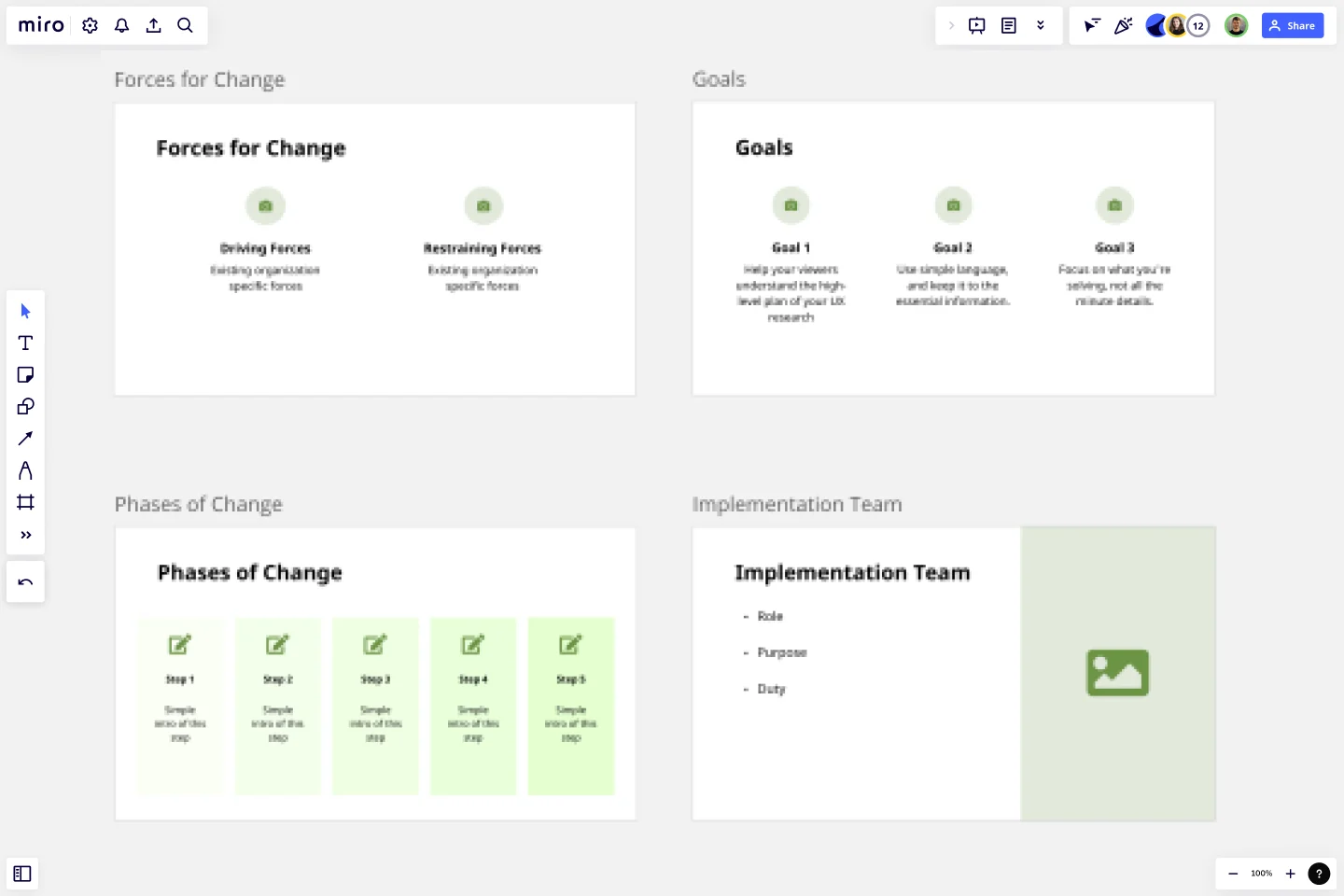
Change Management Presentation Template
Motivate your staff to support change with Miro's Change Management Presentation Template. Explain the benefits of transformation and prevent employee frustration.
Trusted by 65M+ users and leading companies
About the Change Management Presentation Template
Impactful change management communication begins with the right slides. Use our Change Management Presentation Template to help your staff, colleagues, and partners prepare for change and embrace it.
Build awareness, eliminate stress, and get your employees excited about the future transformation. This template allows you to create an effective change management process presentation in minutes and personalize it to match your unique strategy.
What is change management?
Organizations undergo all sorts of human-centered, structural, technological, or cultural changes. These can be proactive or reactive and caused by external or internal factors.
Whatever your case may be, your employees have the right to know what’s happening and how it’s going to affect their work. They also need to understand how to support the transition and make things run more efficiently than before.
That’s where change management comes in. It’s a framework for implementing change and ensuring everyone’s on board. A change management plan helps your entire organization prepare for it and successfully navigate the new landscape, be it a merger, software migration, or major shift in the hierarchy.
Why give a change management presentation?
Contrary to popular opinion, sending a memo isn’t the best way to deliver important news. If anything, it’s guaranteed to sow confusion across the entire company and spark heated debates in the break room. If you want to tell your team about an upcoming organizational change, it’s better to go face-to-face or jump on a video call with them to explain what’s about to come and leave no questions unanswered.
A well-structured change management presentation can help you communicate organizational change effectively and ensure a smooth transition. If you find the right way to tell your employees the big news, you can boost their morale and help them mentally prepare for the shift. They won't be taken aback or outright scared when sudden changes come into effect, and they’ll have time to process them.
How to use the Change Management Presentation Template
You can map out your change management presentation and communication plan on Miro’s infinite canvas. Define your organizational change, highlight its benefits, address challenges, and outline the implementation timeline.
Once the backbone of your presentation is ready, pick this Change Management Presentation Template and start editing it frame by frame. Replace the generic information in the template with your own and tweak its structure by adding or removing slides.
When you’re done customizing your Change Management Presentation Template, switch to Presentation mode . This mode allows you to see the slides as your audience sees them, without any distractions. Use the arrow buttons or keys to navigate between slides. You can always jump back to editing mode if you need to make some adjustments.
Miro is the perfect presentation creator for quickly building presentations using one of many ready-made templates.
Tips for giving a change management process presentation
Show empathy : Speak to your team directly and try to look at the situation through their lens to fully understand how the new order of things is going to affect them.
Address the underlying causes of change : Don’t mask unpleasant truth just to make your organization appear invincible. If financial or legal problems influence the current change, your team will find out about it sooner or later.
Don’t steer away from discussing potential problems : Openly address the “side effects” of the transformation and let your staff know that you’ve performed a thorough risk assessment.
Demonstrate responsibility : Show that you’re aware of what’s at stake and that your organization is pursuing long-term benefits, not short-term wins.
Use facts and numbers : Squeeze the water out of your presentation and populate your change management slides with data from real reports, case studies, or publications to prove why this particular solution or structure is better than what you had before.
Facilitate open communication : Collect feedback and ask questions to understand how ready your staff is to accept the change and what’s holding them back.
Invite participation : Encourage your employees to vocalize their thoughts and worries and welcome any bottom-up initiatives that can help make the transition seamless.
How do I communicate organizational changes to increase trust?
The key is to show your team that you all are leaving your comfort zone for a reason. You’ll have a much easier time convincing your employees to accept change if you stay honest with them and prove that this temporary turbulence is well worth it. Combat uncertainty with facts, avoid false positivity, and focus on long-term goals. Use real-world examples to demonstrate what the future transformation means in practice. Also, make your employees feel seen and respected by recognizing and addressing their fears, concerns, and skepticism.
When is the right time to give a change management presentation?
A strong change management plan requires agility. You don’t want to wait for the perfect moment and end up delivering your change management presentation too late to ease the transition. If rumors about the upcoming change have already started circulating, they’ll negatively affect your company’s image and undermine staff trust. Prioritize timing over the perfect presentation. The goal is to announce organizational change before it’s in full swing and clearly communicate what it means. This way, you’ll prevent misconceptions or panic from spreading far and wide — and inspire genuine organizational commitment.
Get started with this template right now.
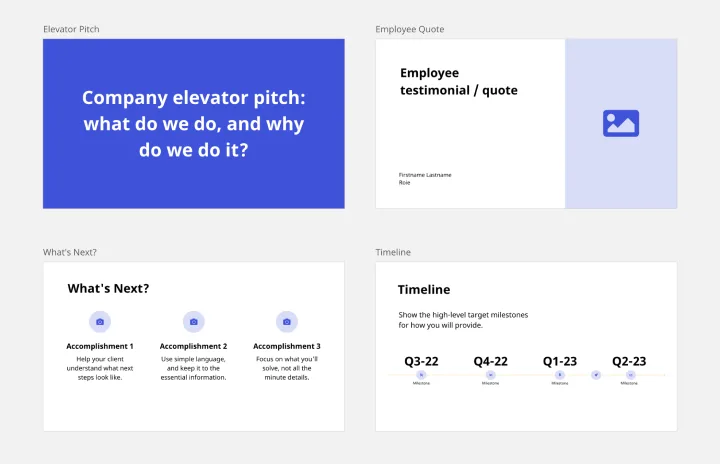
Company Vision Presentation Template
Works best for:.
Presentations, Business Management
Creating or reimagining a company vision is just half the battle. You also need to make sure that your employees and customers understand and share it. Communicate your vision statement in the most effective and concise way with this Company Vision Presentation Template.
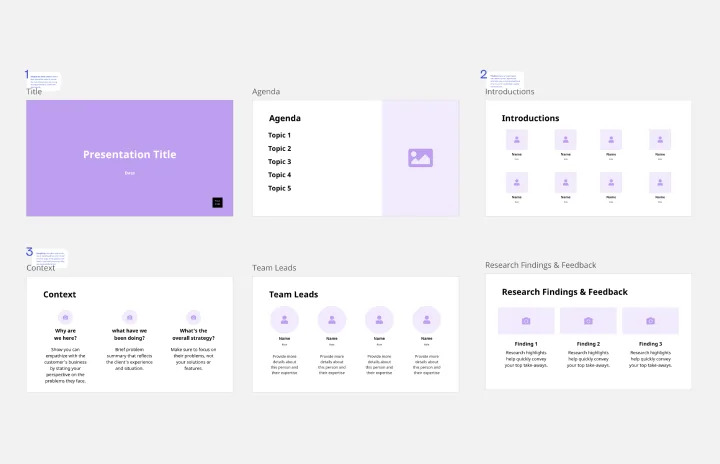
Demo Presentation Template
Presentations, Meetings
Present your ideas confidently and professionally with this Demo Presentation Template. Use it to show potential and existing customers how your product or service works so they can fully appreciate its value.
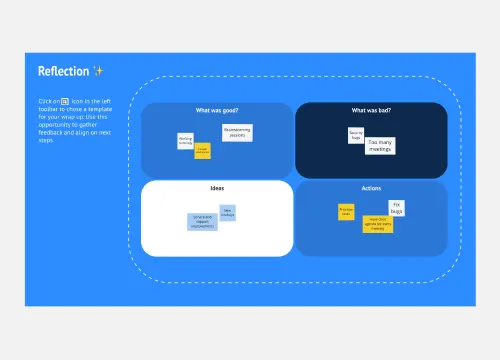
Effective Meeting Template by Zoom
Team Meetings
Run effective meetings and keep everyone focused with Zoom’s Effective Meeting Template. Bring structure and creativity to every online meeting.
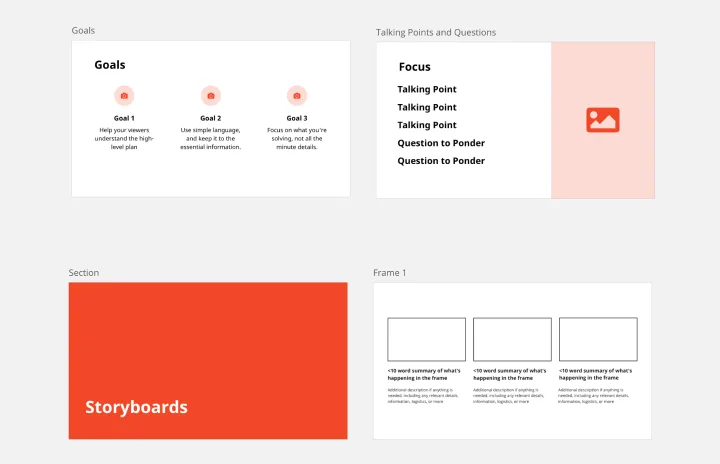
Storyboard Presentation Template
Presentations, Design Thinking
Use this Storyboard Presentation Template to visualize the structure, content, and flow of your presentation. Make sure that your presentation covers all the key points and hits the mark.
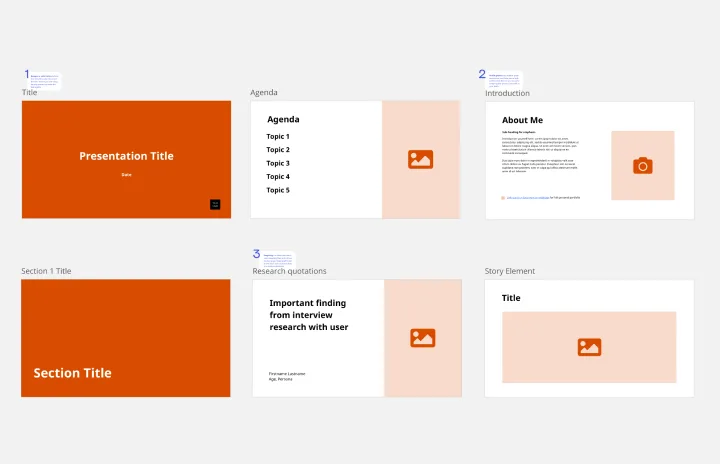
Keynote Presentation Template
Presentations, Workshops
Designed to create enthusiasm and build knowledge about a specific topic, keynote presentations are more powerful than most people think. With them, you get to inspire and unify an audience with a common purpose. We give you an easy way to do this — just use our Keynote Presentation Template to create your own captivating presentation.
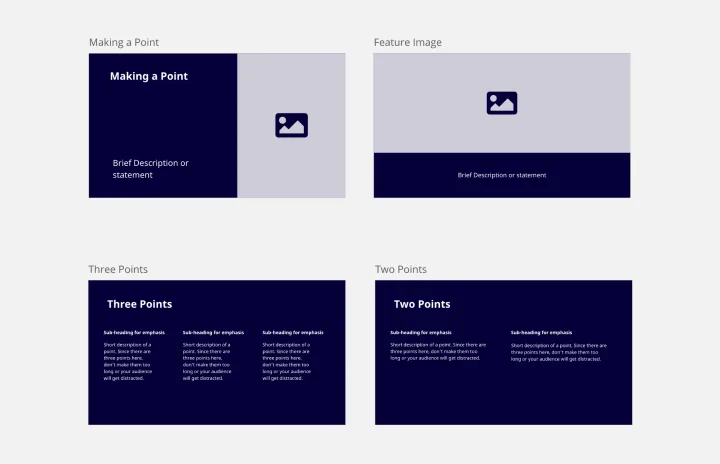
Simple Presentation Template
Presentations
Designed to remove the clutter and communicate the most important information in a clear and visually appealing way, our Simple Presentation Template will keep your audience’s eyes glued to the screen and their ears tuned into your voice — without having to add any fancy bells or whistles.
We use essential cookies to make Venngage work. By clicking “Accept All Cookies”, you agree to the storing of cookies on your device to enhance site navigation, analyze site usage, and assist in our marketing efforts.
Manage Cookies
Cookies and similar technologies collect certain information about how you’re using our website. Some of them are essential, and without them you wouldn’t be able to use Venngage. But others are optional, and you get to choose whether we use them or not.
Strictly Necessary Cookies
These cookies are always on, as they’re essential for making Venngage work, and making it safe. Without these cookies, services you’ve asked for can’t be provided.
Show cookie providers
- Google Login
Functionality Cookies
These cookies help us provide enhanced functionality and personalisation, and remember your settings. They may be set by us or by third party providers.
Performance Cookies
These cookies help us analyze how many people are using Venngage, where they come from and how they're using it. If you opt out of these cookies, we can’t get feedback to make Venngage better for you and all our users.
- Google Analytics
Targeting Cookies
These cookies are set by our advertising partners to track your activity and show you relevant Venngage ads on other sites as you browse the internet.
- Google Tag Manager
- Infographics
- Daily Infographics
- Popular Templates
- Accessibility
- Graphic Design
- Graphs and Charts
- Data Visualization
- Human Resources
- Beginner Guides
Blog Business Change Management Process: Gaining Buy-in and Overcoming Resistance with Infographics
Change Management Process: Gaining Buy-in and Overcoming Resistance with Infographics
Written by: Sara Austin Apr 05, 2021

If there’s one thing that you can count on, it’s change.
New technologies, competitors, regulations and norms require companies to stay flexible to stay relevant. The organizational landscape is always shifting, but the past year has brought unforeseen challenges. Organizations were caught off guard—unprepared for remote work, supply shortages, and employees facing the reality of teaching their children at home.
Organizations weren’t prepared. None of us was prepared. How can you prepare for something nobody expected? Sometimes external factors force you out of your comfort zone.
Change can go smoothly if you plan for it. But even unexpected changes can be managed well if you have the property tools. The field of change management seeks to provide a framework for change that effectively reduces friction and churn.
Read our blog for a clear explanation of change management and what’s involved in the change management process. You can then learn how you can support your change management initiative with visuals (infographics) and how Venngage for Business can help you accomplish your change management goals.
SEE VENNGAGE FOR BUSINESS
Click to jump ahead:
What is change management, who is responsible for change management, why is change management so hard, what are the 3 stages of change, 3 steps in the change management process.
- What is the emotional cycle of change for employees?
How do I evaluate my change management process?
Change management process faq, support your change management initiative with infographics.
Change management refers to the process that an organization or leader follows to create change. Many of the steps and activities related to change management are universal, which means that they apply to individuals as well as small and large organizations. Best practices for change management apply to changes in process, approach and even culture.

Change requires the investment of many stakeholders, from people initiating the change request to those responsible for creating a complete change management strategy . Generally speaking, there are five main roles in change management:
- Practitioners: Practitioners are the individuals who lay the groundwork for the change through plans and strategies.
- Sponsors: Sponsors are individuals with influence in the organization who support and promote the change.
- People managers: People managers help to drive the change as an advocate and coach, working directly with their subordinates.
- Project managers: Project managers operationalize the change and see the change initiative through to adoption.
- People: These are the individual employees who must eventually adopt the change.
Change is hard for many people. When you try to manage change in an organization with multiple people involved, it gets even harder.
To succeed, you will need to be doggedly focused on achieving your objective. It’s kind of like parenting. There will be days when everybody seems to be on the same page and you think, ok, yeah! We’ve got this.
Other days you find yourself in the Valley of Despair ( more information on this below ). In the Valley of Despair, you will wonder what you got yourself into, unsure if you’ve even got what it takes to do the job.
The truth about change is that it takes time, and over the course of that time people have to choose to buy into that change every single day until it becomes second nature. Keeping people on board is a real challenge for leadership.
What do leaders need to successfully manage the process of change? Patience, persistence, resilience, and of course, great training materials.
According to Lewin’s Change Management Model , there are three stages that we all go through when we experience change.
1. Unfreezing
The first stage is unfreezing. Some experts refer to this unfreezing process as getting “ unstuck ”. The way that you have always done it isn’t going to work anymore, so you need to let all that go.
Unfreezing means accepting that change is happening and being open to participating in the process.
2. Changing
Once you’ve thawed out, you are ready for the changing phase. Here is where you begin to put into practice your new methods or strategies.
At the organizational level, this may be where you update all of your new passwords to meet the company’s new security protocols.
At the individual level, this may be where you learn to stop eating pizza after ten. See? Change can be great!
3. Freezing
Finally, you reach the freezing stage. This is when you take what you have learned and make it stick.
Related: 8 Change Management Models and How To Apply Them
Change at the enterprise level is very similar, though on a much larger scale. Unlike many individual changes, organizational level change is very complex and requires a veritable mountain of paperwork. Let’s look at what is need at each level of an organizational change management process.
1. Preparing for change
Preparing for change at the organizational level means doing an in-depth analysis of training needs and working to build a coalition around the change initiative.
2. Managing change
Here is where you really get your hands dirty. Big changes require lots of nurturing and endless amounts of cheerleading, supporting, guiding and informing.
3. Reinforcing change
The truth is the work of change is never really done. Even after victory has been declared, you must continue to reinforce the change, evaluating and adjusting as needed.
3. What is the emotional cycle of change for employees?
Change is more than just learning how to do things differently. It can also be an emotional roller-coaster. The emotional cycle of change looks like a u-curve, going through the following phases:
1. Uninformed Optimism
In this phase, ignorance is bliss. You have all the optimism in the world because you don’t know what you don’t know. As a manager, you want to strike while the iron’s hot and gin up as much enthusiasm as you can.
2. Informed Pessimism
Now that you know a little more about the change and have discussed it passionately with your coworkers, you hate it. This is a great time for managers to promote the goals of the change.
3. Valley of Despair
Now you’re fully in the weeds. Your employees’ early enthusiasm and fervor are gone and right now it just feels like a grind. For managers, this is also a challenging time, but effective and frequent communication can get you over the hump.
4. Informed Optimism
And then, a breakthrough. A small one, but still, a step in the right direction. Things are looking up! Begin to share the small successes that your team achieves along the way.
5. Success and Fulfillment
One day you’ll look around and realize that the change you were looking for is finally here. Well done! Now you can take what you have learned and apply it somewhere else.
Throughout your change management process, it’s important to stay in a cycle of continuous evaluation. Evaluating your change management process helps you keep track of what’s working, what’s not, and what’s next. Here are some questions that you can use to evaluate how you’re doing:
- Did we meet the goals we set?
- What does the feedback say?
- Did we deliver on time?
- Are we getting the return on investment we hoped for?
- Did we stick to the budget?
Not to mention, as you report out the positive impacts of your change management plan , you can increase and solidify buy-in from managers and employees. Everybody likes a winner. Share your successes both big and small.
1. What are 4 things that are key to change management?
- Communication
2. What are change management tools?
Readiness assessments, communication plans, internal change communications, change management training for leaders, change management training for employees.
Related : 7 Change Management Tools to Simplify Change Processes and Effectively Manage Change
3. What is the first stage for change management?
Preparing your organization for change involves evaluating the stakeholders impacted by the change and gaining buy-in to help you promote the change. You should do an in-depth analysis of what your organization needs to get unstuck and develop a clear roadmap for the path ahead.
4. What are the 2 types of change management?
Technically, there are two types of change management: individual and organizational .
However, remember that change management goes through the same process regardless of whether it is a change for thousands or just for you. One change requires a ton of paperwork and the other requires a lot of self-discipline.
Which one is harder? That part’s up to you.
Do you know what your change management project needs?
High-quality documentation with high-impact visuals!
Data visualizations like infographics are one of the most effective tools for change management communication . Fortunately, you don’t have to hire a designer when you can use these templates to create graphics, presentations, checklists, and much more. Let’s check out a few:
Every change begins from where you stand right now. This template can be used to assess your organization’s current skills, beliefs, and attitudes. The data you collect will give you insights on when, where, and how your change management communications should be handled.

CREATE THIS CHECKLIST TEMPLATE
These templates for communication plans can be used to convey important information to your stakeholders, setting expectations for how communications about the change process will be delivered, and who employees should go to in a crisis.

CREATE THIS PLAN TEMPLATE
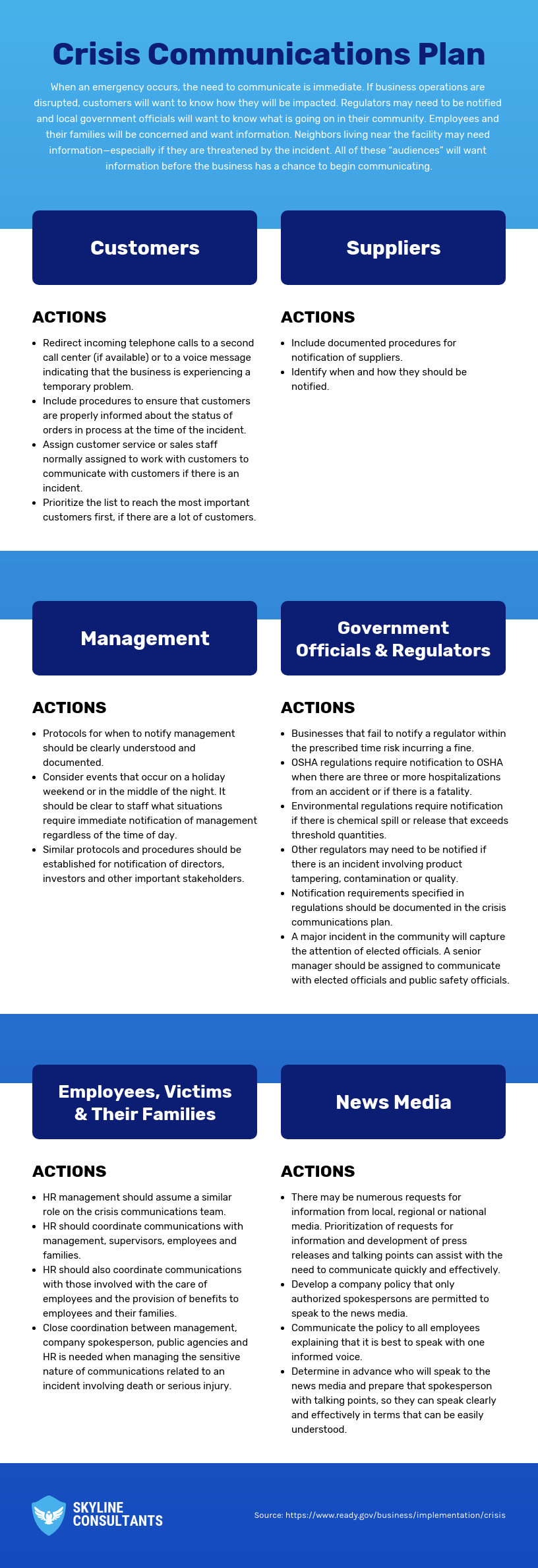
When it comes to the management of change processes, how you communicate is as important as what you communicate. Using these templates, you can establish a standard for communication across stakeholders.

CREATE THIS INFOGRAPHIC TEMPLATE

CREATE THIS NEWSLETTER TEMPLATE
Presentations are powerful tools for learning when they are well-organized, thoughtfully designed, and full of relevant content. This template is easy to personalize for your presentation.

CREATE THIS PRESENTATION TEMPLATE
With most organizational change efforts comes new processes and procedures. Some might even say that is the worst part. No more. With this template, you can create an attractive reference that employees will keep and use.

You can’t fix it if you don’t know what’s broken. Collecting feedback is another essential part of change. This customizable template can help you create a survey that people will actually respond to.

CREATE THIS REPORT TEMPLATE
Creating change can take a long, long time. If you don’t want to have to keep repeating yourself or cleaning up misunderstandings or confusion, investing in high-quality documentation and training aids is a great choice.
With Venngage for Business , even people without any previous design experience can create high-impact documents that employees and other stakeholders can use for ongoing training and reference. Help your change stick with memorable visuals so you can focus on what’s next.
START CREATING FOR FREE
Discover popular designs

Infographic maker

Brochure maker

White paper online

Newsletter creator

Flyer maker

Timeline maker

Letterhead maker

Mind map maker

Ebook maker
Free Change Management Strategy Templates
By Kate Eby | December 10, 2023
- Share on Facebook
- Share on LinkedIn
Link copied
We’ve collected the most useful free change management strategy templates in Microsoft Word, Excel, PowerPoint, and Google Slides formats. These templates can help your organization strategize, present, and manage change projects successfully.
Included on this page, you’ll find a change management strategy presentation template , a change management communication template , and an o rganizational change management strategy presentation template .
Change Management Strategy Template
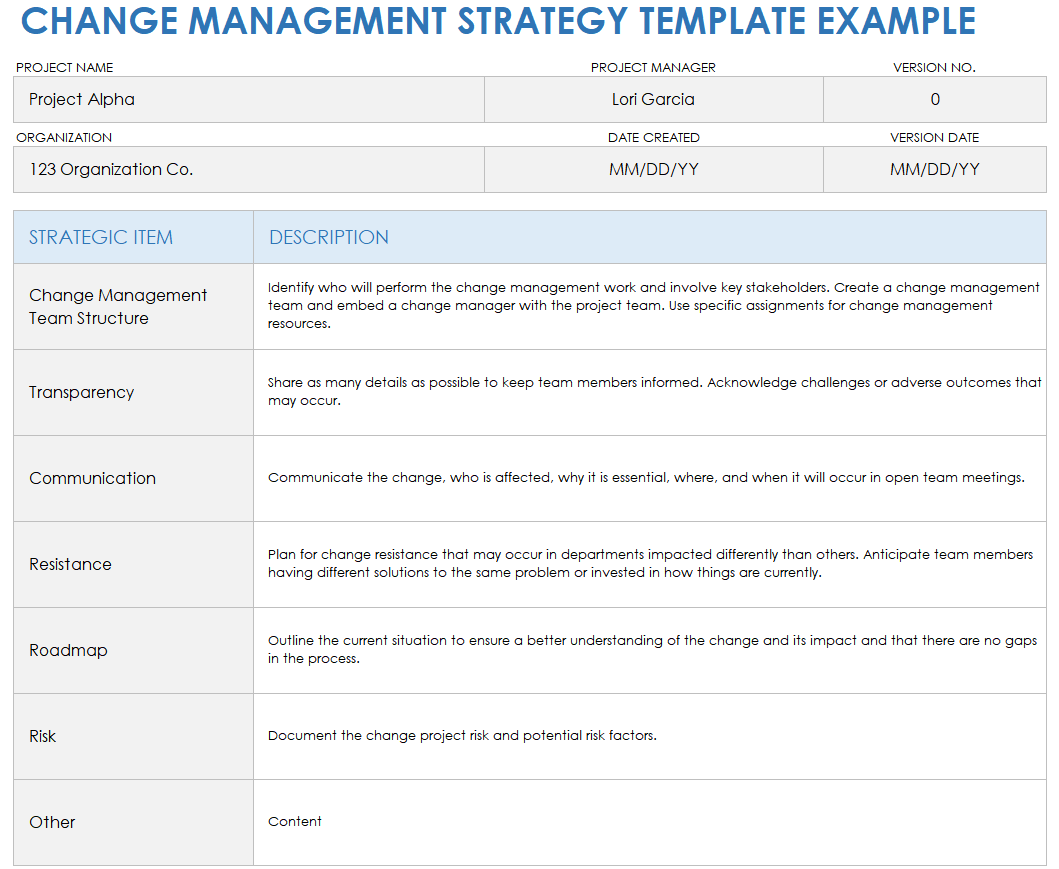
Download a Sample Change Management Strategy Template for Excel | Microsoft Word
Download a Blank Change Management Strategy Template for Excel | Microsoft Word
This change management strategy template helps lay the groundwork for your change project before the implementation phase. The template includes a version with sample content that can help guide your team as it outlines its change management strategy. Enter the project, project manager, organization, version, and dates in the fields at the top of the template. Detail the strategic items, beginning with team structure and transparency, and add descriptions that outline your approach in the two-column table.
Check out these free change management templates to help your organization achieve successful change outcomes.
Change Management Strategy Presentation Template
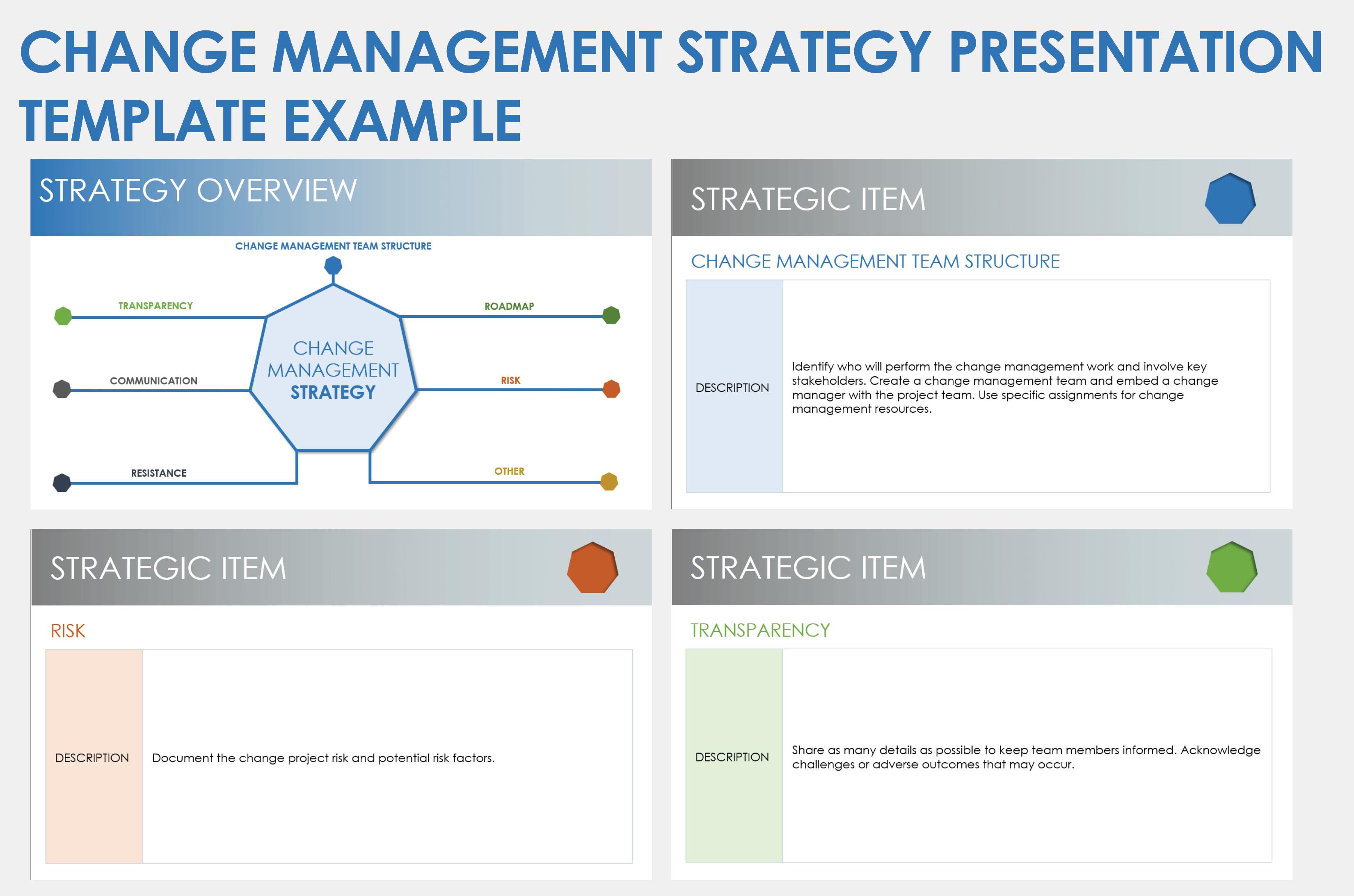
Download a Sample Change Management Strategy Presentation Template for PowerPoint | Google Slides
Download a Blank Change Management Strategy Presentation Template for PowerPoint | Google Slides
Outline, present, and share your change management strategy with this slide presentation template. The example version features content that helps you form your change management strategy before implementation. Input the project name, organization, version, and date(s) in the title slide. Show your stakeholders that you’re prepared to respond to change with strategies for structuring your team, roadmapping, and assessing risk.
Check out this collection of free PowerPoint change management templates to inform and update stakeholders during change processes.

Change Management Communication Strategy Template
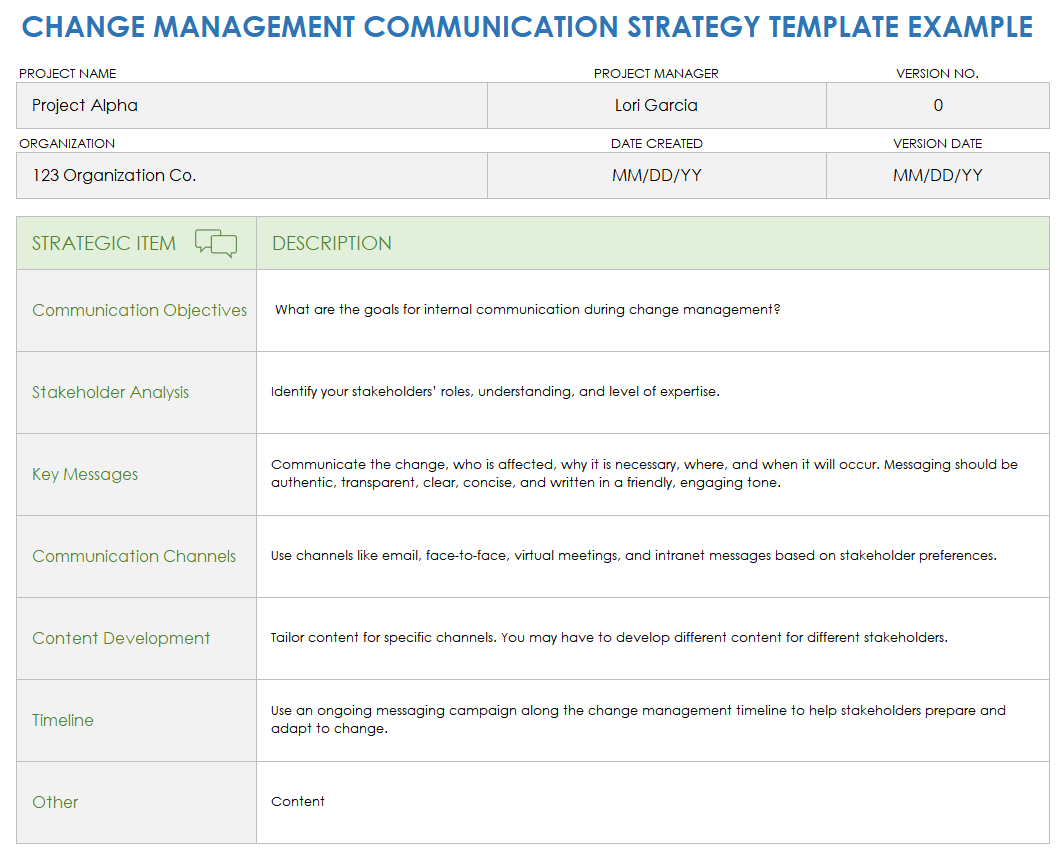
Download a Sample Change Management Communication Strategy Template for Excel | Microsoft Word
Download a Blank Change Management Communication Strategy Template for Excel | Microsoft Word
Document your change management communication strategy with this customizable template. This powerful tool includes sample content for all the necessary strategic categories. Input your change strategies for communicating objectives, articulating key messages, and developing content in the template table. Use the stakeholder analysis row to strategize and ensure stakeholder awareness and comprehension of the change process.
To keep stakeholders up to date, check out these free change management communication plan templates that outline communication purposes, messaging, and channels.
Change Management Communication Strategy Presentation Template
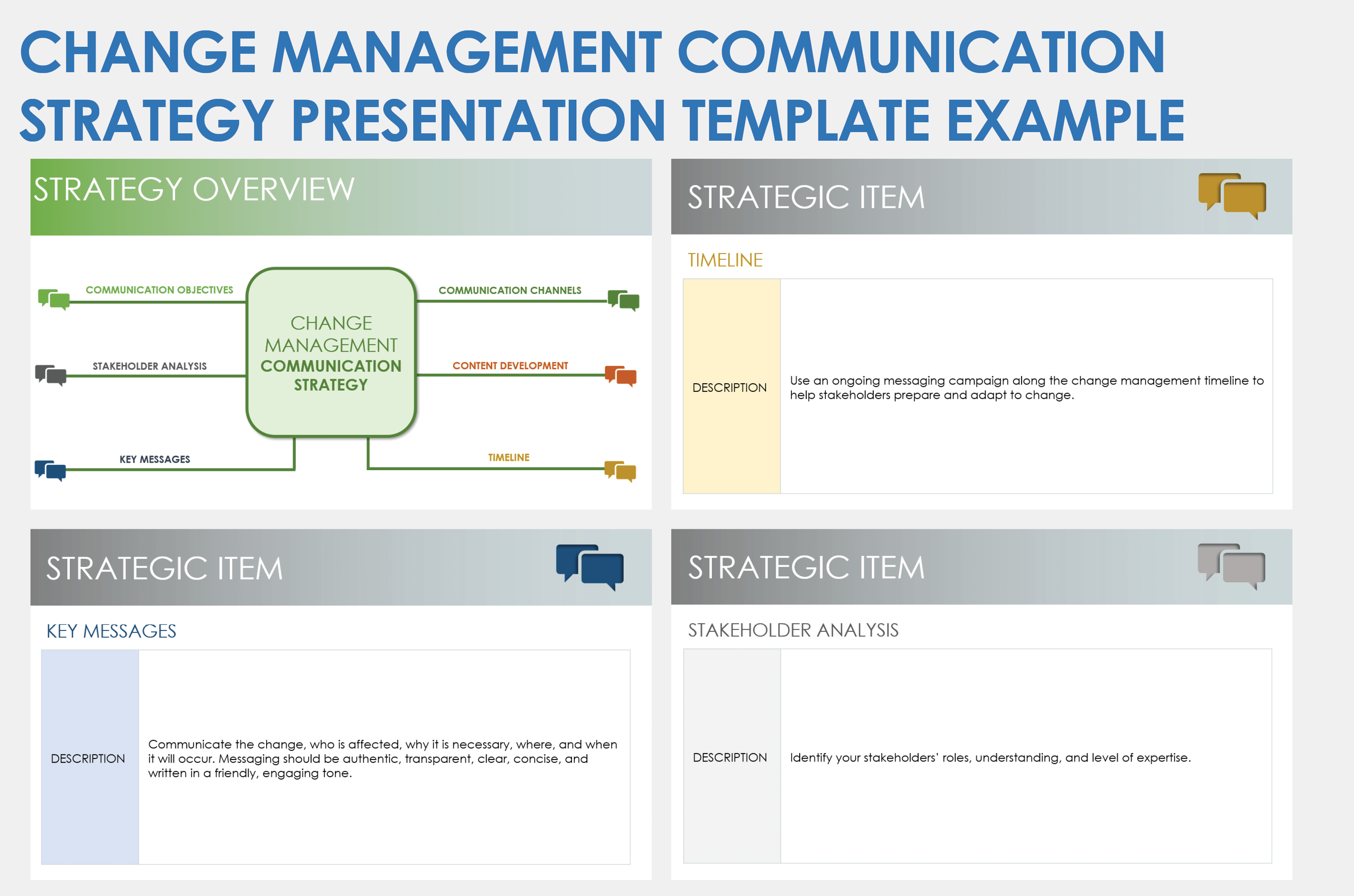
Download a Sample Change Management Communication Strategy Presentation Template for PowerPoint | Google Slides
Download a Blank Change Management Communication Strategy Presentation Template for PowerPoint | Google Slides
Create and present your change management communication strategy with this template. The example content helps you convey your strategy clearly and effectively. You can create and detail key strategies for communication objectives, channels, content development, and more. This slide presentation template has everything you need to present and share your change management communication strategy.
With this essential guide to every aspect of change management , you’ll gain all the insight you need (including models and tips) to achieve successful change.
Organizational Change Management Strategy Template
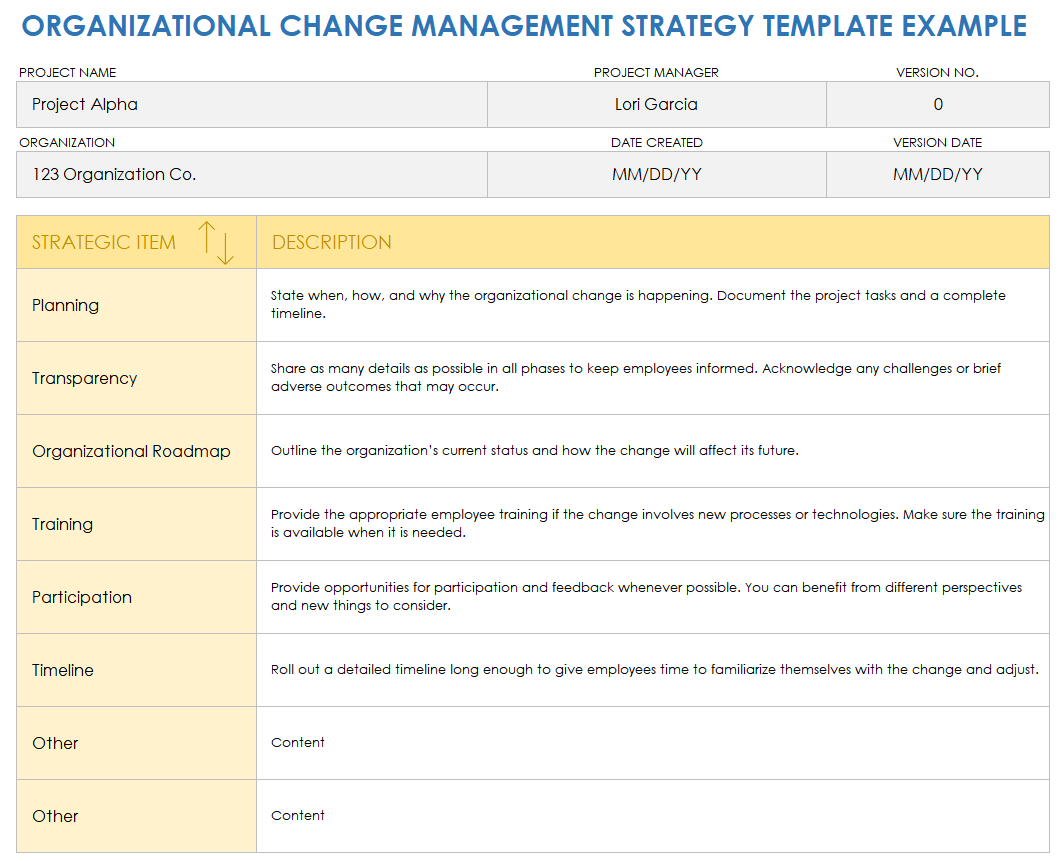
Download a Sample Organizational Change Management Strategy Template for Excel | Microsoft Word
Download a Blank Organizational Change Management Strategy Template for Excel | Microsoft Word
This organizational change management strategy template enables your organization to outline a precise and coherent change strategy. The sample version of this template provides additional descriptive guidance. The two-column table features organization-specific strategic items, such as planning, transparency, training, and roadmapping, to help ensure effective change. This template lets your organization share a streamlined yet comprehensive strategic vision for its change project.
Learn more about change management planning, best practices, and tips with this comprehensive guide to writing the most effective change management plan .
Organizational Change Management Strategy Presentation Template
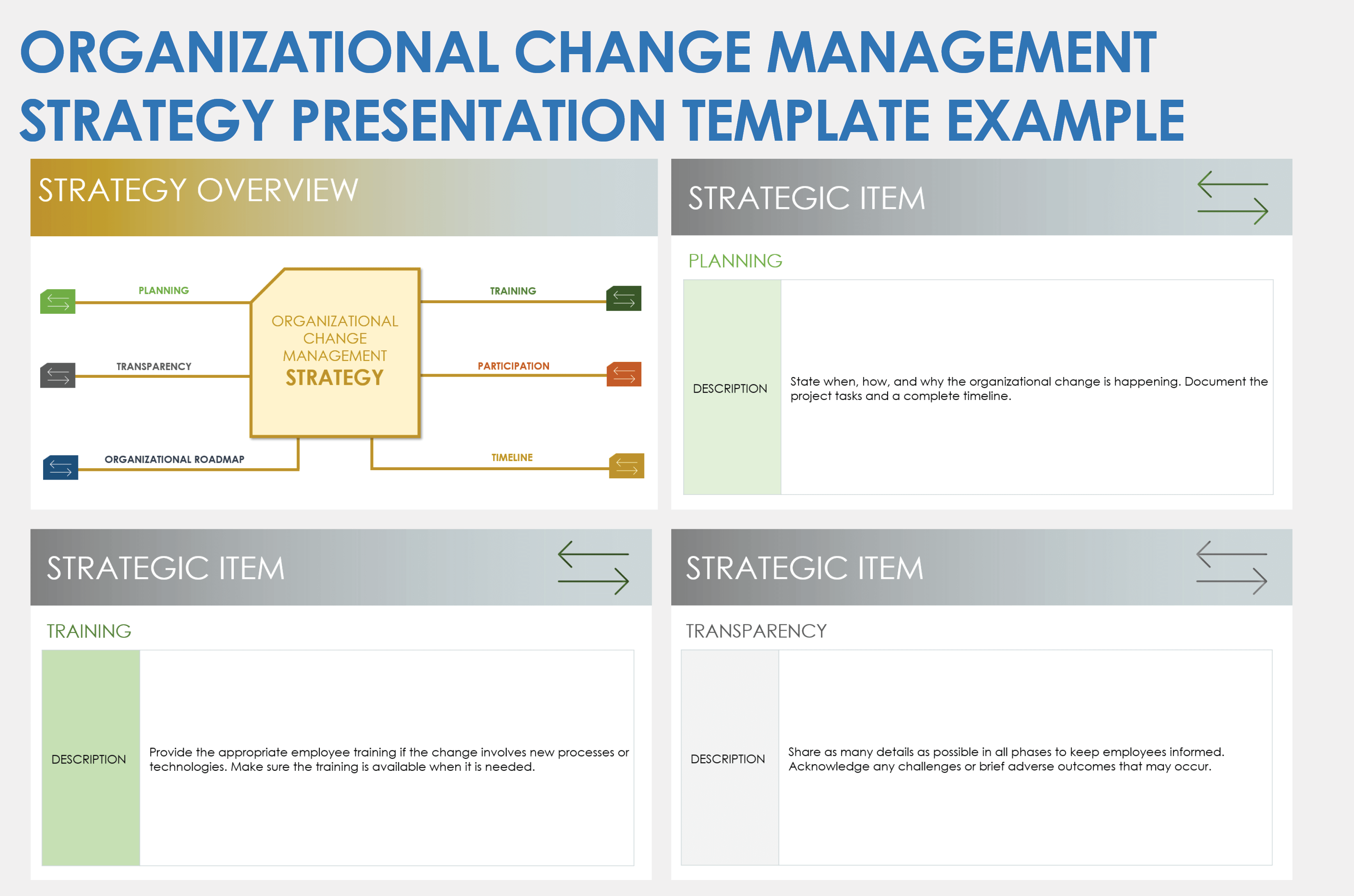
Download a Sample Organizational Change Management Strategy Presentation Template for PowerPoint | Google Slides
Download a Blank Organizational Change Management Strategy Presentation Template for PowerPoint | Google Slides
You can present a precise yet comprehensive organizational change management strategy with this customizable template. The template includes example content for organizational change management strategy. Enter brief descriptions for strategic items, such as an organizational roadmap and timeline. This tool provides everything you need to highlight your change management strategy for employees and other stakeholders.
Master Your Change Management Strategy With Smartsheet
Empower your people to go above and beyond with a flexible platform designed to match the needs of your team — and adapt as those needs change.
The Smartsheet platform makes it easy to plan, capture, manage, and report on work from anywhere, helping your team be more effective and get more done. Report on key metrics and get real-time visibility into work as it happens with roll-up reports, dashboards, and automated workflows built to keep your team connected and informed.
When teams have clarity into the work getting done, there’s no telling how much more they can accomplish in the same amount of time. Try Smartsheet for free, today.
Discover why over 90% of Fortune 100 companies trust Smartsheet to get work done.
How do we manage the change journey?
In Beyond Performance 2.0: A Proven Approach to Leading Large-Scale Change (John Wiley & Sons, 2019), McKinsey’s Scott Keller and Bill Schaninger draw on their long experience, and the most comprehensive research effort of its kind, to provide a practical, proven guide for executives managing corporate transformations. “ A better way to lead large-scale change ,” the first article in the series, explains how and why the authors’ approach works. The second, “ Getting personal about change ,” provides an in-depth look into the mind-set shifts required for generating meaningful change. The third, “ The forgotten step in leading large-scale change ,” examines the most often neglected stage of the change process. This fourth article discusses how to generate ownership and energy for success.
Change is a journey, and few journeys go according to plan. Leaders who follow the transformation methodology explained in our new book, Beyond Performance 2.0, take companies through what we call the five stages of performance and health. 1 The five stages, and the questions that must be answered in each of them, are aspire: Where do we want to go?; assess: How ready are we to go there?; architect: What must we do to get there?; act: How do we manage the journey?; and advance: How do we continue to improve? This article focuses on the fourth: act. To ensure that plans developed in the previous stage ( architect ) stay on track and evolve when necessary, leaders must give employees a sense of ownership in the process, as well as the energy needed to change. This article shows how.
Instilling ownership
The previous stages of our five-stage program will give employees a significant degree of ownership. But don’t assume it will continue throughout the act stage. To see that it does, establish strong governance, scale up initiatives appropriately, and monitor and adjust them as needed.
Establish strong governance
Research shows that change programs with governance structures clearly identifying roles and responsibilities are 6.4 times more likely to succeed. The vast majority of successful programs include four such elements: an executive steering committee (ESC), a change-management office (CMO), executive sponsors (ESs), and initiative owners (IOs) and their teams.
An executive steering committee typically includes the most senior leader and a senior executive team. It owns the change program’s overall direction; makes critical ongoing decisions, such as approving changes in execution plans, reallocating resources, resolving issues, and reshaping initiatives; and holds people accountable for results. When the ESC communicates the progress of change programs frequently during the act stage, they are a whopping eight times more likely to succeed.
The change-management office coordinates the overall program, tracking its progress, resolving issues, and facilitating transparent, effective interactions between the ESC and the initiatives. It seldom leads them but sometimes helps share best practices and acts as a thought partner for initiative teams. Typically, a full-time senior leader responsible for the overall change program runs the CMO. Its size depends on the transformation’s nature, but it typically includes resources for monitoring and reviewing activities, metrics, budgets, and impact, as well as for communications and change management.
Executive sponsors provide guidance, judgment, and leadership for initiative teams by reviewing their progress, helping periodically to solve problems, suggesting and validating changes to execution plans, and focusing on the business impact. They may be either members of the ESC or senior leaders, one level down, who directly own particular initiatives. The ES strives to optimize particular initiatives; the ESC, the full portfolio.
Initiatives are executed by initiative owners and their teams, who typically work for line organizations but may also come from staff functions. IOs generally help formulate the initiative charter; identify resources, operating expenses, and capital requirements; determine the scale-up approach; and develop timelines and milestones. Their responsibilities include both problem solving and people solving.
The CMO provides support and oversight. But accountability for the impact of initiatives should be placed, so far as possible, with line management and built into relevant budgets—no aspect of a change program is complete until they fully reflect it. Programs with clear roles and responsibilities are six times more likely to succeed than programs that don’t; those with effective CMOs, twice as likely.
To understand this governance model, consider the case of a retailer restructuring its global operations after quarterly losses. When an organizational-health survey identified many health issues, the CEO created an ESC comprising senior leaders from the retailer and its parent company. The retailer then created a CMO led by the respected senior manager of its most profitable business line. He enlisted one of his top performers and two respected middle managers from other departments and hired an external change expert and a retail-turnaround specialist. Each of the 25 health initiatives identified in the architect stage had an IO and ES who helped ensure that teams remained committed to targets and had the necessary resources. The teams also included part-time “project amplifiers,” who publicized initiatives to the organization and communicated its concerns back to the teams.
This clear ownership model helped the retailer to reorganize its 75,000-strong workforce and to cut costs by 12 percent within six months. The whole company’s health improved significantly. The program’s light yet robust structure was easily dismantled, and the business then took responsibility for the ongoing effort.
Choose scale-up methods
Companies implement the vast majority of initiatives by testing ideas, learning from failures, and scaling up successes quickly—an approach that limits damage, provides valuable lessons, and builds an appetite for change. But impatient organizations often implement pilots too quickly.

Beyond Performance 2.0: A Proven Approach to Leading Large-Scale Change
Consider the experience of the Netherlands-based insurance group Achmea. Spurred by the government’s radical healthcare reforms, the company launched a change program in one of its divisions. The initiatives included a plan to raise the call center’s efficiency by 25 percent and to improve the customer experience. Achmea’s initial pilot was a huge success, but the company soon found that the approach of the manager who led the effort was hard to replicate because he had relied on personal influence, not new systems . As this example shows, the pilot phase should include two tests: proof of concept (to establish that an idea creates value) and proof of feasibility (to ensure replicability). Often, this second test also trains leaders for later waves of implementation. Once Achmea adopted the double-pilot approach, the change program proceeded successfully.
Companies can choose among three broad “flavors” for scaling initiatives: linear, geometric, and “big bang” (Exhibit 1). In the first, the proof-of-feasibility pilot is replicated across the organization, but no area starts until the previous one finishes. This works best if a company rolls out an initiative in only a few areas and isn’t in crisis, the stakes are high, deep dives by experts are needed, resistance to change is strong, and the tool kit and solutions require extensive customization.
In geometric scale-ups, implementation occurs in progressively bigger waves. This makes sense if multiple areas share a few common features, many areas must be transformed, a linear approach would take too long, capable implementers are readily available (or can be trained ahead of demand), and the organization can absorb the changes. In big-bang scale-ups, implementation occurs across all relevant areas at once. That takes many resources, but for a relatively short time, and makes sense if multiple areas share many features, the transformation is urgently needed, little resistance is expected, and the company can deploy a standard tool kit.
A multinational energy company, for example, used the linear approach to roll out unified HR software that replaced freestanding national systems. Senior management understood that if the company switched in one go, or even region by region, technical issues might overload the project. The new software represented a major shift, so the company also wanted to ensure that all country organizations embraced it and that concerns at any one location could be addressed before the rollout continued.
But this company chose a geometric approach to implement its new global procurement strategy. An analysis of vendor relationships uncovered similarities among markets in buying patterns and levels of procurement sophistication and vendor choice. Grouping similar markets into clusters enabled the company to increase its leverage with vendors. It then used the geometric approach to roll out the project in increasingly large groups of regions and countries. Procurement teams got up to speed quickly, approaches were progressively refined, and cost savings escalated rapidly.
Another initiative revamped public-relations processes. The company had recently experienced a crisis it hadn’t handled well, because of a decentralized approach to managing its public image. One initiative therefore centralized stakeholder management and PR, installed new policies and guidelines, and aimed to make the general public and key stakeholders aware of the company’s efforts to improve transparency and accountability. A big-bang effort fully implemented the program in two months.
Monitor progress and adjust the program dynamically
To work effectively and scale up multiple initiatives during the act stage, the CMO must provide both an initiative- and program-level view of progress and impact through relevant metrics and milestones. When it does, change programs are 7.3 times more likely to succeed. This mandate requires good data. As N. R. Narayana Murthy, former chairman of Infosys, put it, “ In God we trust; everybody else brings data to the table .”
To have a robust view of how much progress you’re making, regularly measure your change program on at least four dimensions:
- Initiative level. Track initiatives not just by time (milestones) and budget (money spent versus planned) but also by operational performance (cycle times, waste, wait times, quality).
- Health. Are management practices and their underlying mindsets and behavior shifting appropriately? Targeted analytics, surveys, focus groups, and direct observation of work sites offer a good read.
- Performance. Measure key business outcomes (revenues, costs, risks) to confirm that improvements happen where you expect and don’t cause problems elsewhere.
- Value creation. Constantly focus on the ultimate goal: shareholder (and other relevant stakeholder) value.
The particular metrics to monitor in each dimension will be specific to individual programs, but less is more: metrics often cascade into unwieldy, complex permutations. A McKinsey analysis shows that organizations use only 29 percent of the metrics they claim to follow in change efforts .
Next, decide how often to measure and review the metrics. In large-scale change programs, initiatives should be reviewed weekly by their teams; health and performance, monthly or quarterly by sponsors and steering committees; and enterprise value, once or twice a year by everyone in the program. Reviews enforce accountability, identify issues and best practices, determine remedies, spotlight successes, and instill a culture of continuous learning and improvement.
Don’t confine the monitoring and review to the past. As Telefónica de España’s former managing director and COO Julio Linares warns, “The market is going to change constantly, and because of that you need to make a constant effort to adapt to the market. Of course, some parts of the program will end, but new ones will come up.” Change programs led by CMOs that adjust them as needed are 4.6 times more likely to succeed. 2 McKinsey global transformational-change survey of 2,314 executives, conducted in January 2010.
No matter how well you plan initiatives during the architect stage, some will probably flounder when you get to act: 28 percent of well-planned initiatives don’t deliver the results forecast , so the CMO should expect to redirect or stop some initiatives, launch new ones, and reallocate resources quickly. Our data show that, on average, the execution end dates of 31 percent of initiatives change once , 28 percent twice, and 19 percent three times. The CMO’s role is to ensure that this happens for the right reasons, with rigorous problem solving and no last-minute delays or surprises—a reason to monitor metrics weekly.
Health: Generating energy
During change programs, employees must conduct everyday business while changing the way it’s done. That additional work requires additional energy, so change leaders must ensure that programs generate more of it during the act stage than they consume. Change leaders can create energy by mobilizing influencers, making change programs personal for a critical mass of leaders, and engaging the workforce with two-way communications.
Mobilize influencers
Senior leaders aren’t the only people who guide employees; influencers deep in organizations can disproportionately affect their colleagues’ energy levels if a change program excites them. Regardless of their official title or status, they draw power from the many personal contacts who respect and emulate them. Malcolm Gladwell’s best seller The Tipping Point 3 Malcolm Gladwell, The Tipping Point: How Little Things Can Make a Big Difference, Boston, Massachusetts: Little, Brown and Company, 2000. describes three types: “mavens” accumulate knowledge and share advice, “connectors” know many people, and “salespeople” can naturally persuade others. Our research indicates that engaging influencers in change programs makes them 3.8 times more likely to succeed.
Consider the example of a change program for maternal healthcare in Africa. No traditional form of intervention (such as pamphlets) worked. Eventually, the leaders realized that hairdressers were extremely influential—hair salons were among the few places where young women could talk about the health of mothers. When the campaign refocused on hairdressers, the message got through.
You can find these sometimes-hidden influencers through social-network analysis (Exhibit 2). One application—“snowball sampling”—uses techniques social scientists developed to study hidden populations: two- to three-question surveys ask employees to nominate (anonymously) three to five people whose advice they respect. These five are also surveyed, and the survey ends when names are repeated—often, after only three to four rounds. Leaders frequently find the results surprising because influence patterns rarely reflect organizational charts.
Companies can mobilize influence leaders effectively in many ways–for example, enrolling them in pilots. At the very least, create a two-way pipeline giving influencers early access to information, so that you gather important feedback on the program’s implementation. By using this group to refine new ideas, you can also increase the effectiveness and acceptance of the ideas you implement.
Make change personal for a critical mass of leaders
Mindsets created by an old stimulus last far longer than the stimulus itself, so if you rely solely on changes in the work environment (a new stimulus) to shift mindsets, you’ll wait a long time. What’s more, changes to the work environment won’t affect everyone similarly. Finally, and perhaps most vexingly, to change the work environment, programs must rely partly on leaders to role model the new behavior, even in the absence of any significant external stimulus. Companies must therefore recognize that the biggest barrier to personal change is overcoming the propensity to see other people as the problem.
At one company, for example, we asked leaders to estimate how much time they spent tiptoeing around other people’s egos. Most said 20 to 30 percent. Then we asked these leaders how much time an employee might spend tiptoeing around their egos. Most were silent. Our research shows that 86 percent of leaders claim to role model behavioral changes, but only 53 percent of the people who report to them agree.
Our journey to find ways of kick-starting change among leaders has led to the development of what we call personal-insight workshops (PIWs), which mostly take place offsite, in groups of 20 to 30, over a couple of days. During PIWs, facilitators who understand the principles of adult learning and human-potential techniques take participants through the “U-process,” which involves three phases.
The first, sensing, typically takes 30 percent of the workshop’s time. Participants explore the company’s change story in the context of their own. During the second phase, presencing, which typically accounts for some 40 percent of the workshop’s time, the session turns further inward.
Participants examine their beliefs about what’s possible in the workplace, reflecting on questions such as “when do I feel in the ‘flow’ and what takes me out of it, into fight-, flight-, or freeze-type responses?” “What has conditioned me to respond in this way?” “Can I respond in a different way if I frame situations differently?” “What are the benefits and risks if I do?” “How would these different ways of thinking and acting create a more powerful personal legacy?” “How does all this link to the bigger organizational change discussed in the sensing phase?” These techniques help participants to understand their attitudes toward (and more fully embrace) the change program’s organizational mindset and behavior shifts and therefore increase their impact as role models.
Now the U-process enters its third phase: realizing, which typically accounts for 30 percent of the workshop’s time. Here participants decide how they will apply the insights from the previous phase in their day-to-day work, how to use their personal networks to mobilize support, and what the group will do collectively.
Companies will see material shifts in the leadership’s role-modeling impact once a critical mass of 25 to 30 percent of their people leaders attend such programs. At this point, many leaders are replacing the “if only they would change” mentality with the ethos of “if it’s to be, it’s up to me,” so that it becomes contagious and spreads to the whole population. 4 For example, see Andrea Baronchelli, Joshua Becker, Devon Brackbill, and Damon Centola, “Experimental evidence for tipping points in social convention,” Science, June 2018, Volume 360, Number 6393: pp. 1116–19, science.sciencemag.org. Not every successful change program uses PIW techniques, but in our experience every change program that did succeeded. In particular, we’ve seen PIWs thaw the change-resistant “frozen middle” of managers more quickly and effectively than any other approach.
Use high-impact two-way communications
The final element of the act stage—high-impact two-way communications that energize the organization—makes change programs four times more likely to succeed. Consider an experiment involving two groups of people: “tappers” and “listeners.” 5 Chip Heath and Dan Heath, “The curse of knowledge,” Harvard Business Review, December 2006, hbr.org. In a preparatory session, the tappers were told they would drum out the rhythm of famous tunes, such as “Happy Birthday to You,” with their fingers. The listeners would have to guess what it was. Then the experimenters asked the tappers to predict what proportion of the songs the listeners would identify correctly. They guessed half. The actual result was 2.5 percent. As the tappers tapped, they became visibly frustrated with the bewildered listeners. The lesson: if you know something, you find it hard to imagine not knowing it—“the curse of knowledge.”
We constantly see it at work in change programs. Leaders who have been deeply involved in creating the change story assume that others will absorb it quickly. But when anyone first hears the story, what leaders consider carefully crafted messages come across as disconnected ideas. To break the curse, use a combination of four approaches.
First, leaders who retell a story should understand what it’s like to hear it for the first time by testing it on others. Second, make the message stick by relentlessly repeating simple, memorable language; Walmart’s “ten-foot rule,” for example, supports customer service by reminding frontline employees that whenever they are within ten feet of a customer, they should look him or her in the eye, smile, and ask how they can help. As Willie Walsh, who has been chief executive of several airline companies, puts it, “The simpler the message, the easier it is to deliver. The simpler the message, the more likely it is to be consistent. The simpler the message, the easier it is to control and manage the communication.” 6 Personal interview.
A third way is to move from “telling” to “asking,” which uses even chance encounters effectively. Emerson Electric’s CEO David Farr asks virtually all employees he meets four questions: “How do you make a difference?,” “What improvement ideas are you working on?,” “When did you last get coaching from your boss?,” and “Who is the enemy?” 7 The right answer is competitors, not some other department. This way of engaging employees has far more impact than simply exhorting them about the company’s health themes: alignment, continuous improvement, coaching, and collaboration.
The fourth way of overcoming the curse is to ensure that many channels—speech, print, online, symbols, rituals—reinforce your messages. In fact, the best two-way communications programs not only tell the same story through multiple channels but also tell different aspects of it through different channels. Companies should use channels creatively—particularly social media. We’ve seen successful two-way communications strategies involving blogs, tweets, videos, podcasts, “jams,” 8 Online, topical, time-bound problem-solving sessions often involving thousands of employees. and online Wiki-like resource centers tailored to employee segments. These become even more powerful when interwoven with in-person formats, such as large group offsites and unannounced visits.
Equally important, create bottom-up channels. When Lisa Hook was Neustar’s CEO, she sponsored a video competition to communicate the company’s performance-and-health strategy. Employees submitted videos and voted for them online; the executive committee chose the winner and the CEO presented an award. Likewise, during a change program in the early 2000s, employees of the Australian telecommunications company Telstra created a “rogue” comic strip to challenge cynicism about a change program. The corporate center can seed such bottom-up efforts, but they must spread autonomously. Infrastructure and funding may be needed, and some companies give influence leaders a small budget and a mandate to “start a fire” (create energy for change).
Some powerful channels for changing mindsets and generating energy are often underutilized—for instance, new rituals. When a mining company made safety a theme of its change program, it started meetings with announcements about emergency exits and safety hazards. Another underutilized channel is the outside world. As Banca Intesa’s former CEO Corrado Passera reflects, internal results matter little “if everyone keeps reading in the newspapers that the business is still a poor performer, is not contributing to society, or is letting down the country as a whole.” Change leaders should look for ways of leveraging customers, users, and other stakeholders to generate energy for change.
Organizations can maximize a multichannel strategy’s power by starting with an employee segment and mapping its change-experience journey. Employees may, for example, learn about the change program in an offsite interactive story-cascade session, read about it on the company’s home page, and see posters about it on walls at work. At home, they may learn about it in the press. Next, they could take part in a skill-building “field and forum” journey to improve as change leaders. Eventually, they will notice how changing structures, processes, systems, and incentives are realizing the change story’s vision and plan. Employees experience a coherent, reinforcing journey taking them from their previous mindsets and behavior toward those needed to make change programs succeed.
Masterstroke: Motivate through social contracts
In each of our five stages of performance and health, we emphasize a masterstroke: counterintuitive lessons from the field of predictable irrationality. Discounting them causes frustration and delay; leveraging them can greatly accelerate a change program’s impact. In this, the act stage, the masterstroke involves incentives.
Conventional wisdom is clear: if compensation isn’t linked to the objectives of a change program, employees believe that it isn’t important. Unfortunately, however, the upside to linking change objectives to financial compensation is generally limited, practically and psychologically. In practice, compensation can rise only within limits and reflects many metrics: overall company performance, the P&L of individual areas, and so forth. No one metric affects overall results significantly. Changing a company’s approach to compensation is also hard—typically requiring board approval—and unintended consequences may ensue.
From a psychological standpoint, the benefit of increased income on happiness greatly decreases beyond $75,000 a year. Besides, financial incentives become less effective the more organizations use them. 9 Angus Deaton and Daniel Dahneman, “High income improves evaluation of life but not emotional well-being,” Proceedings of the National Academy of Sciences, Volume 107, Number 38, September 2010, pp. 16,489–93. Fortunately, leaders needn’t rely heavily on compensation to drive change; they can stimulate motivation by using what the field of predictable irrationality calls a social—not a market—exchange. Say you go to someone’s house for dinner and afterward ask your host how much money you owe her. The offer of money changes a social interaction into a cringeworthy market transaction. Yet if you had brought your host a bottle of good wine, she would have accepted it gladly. A gift is a symbol of long-term, reciprocal social norms rather than short-term, transactional market norms. 10 Dan Ariely, Predictable Irrationality: The Hidden Forces that Shape Our Decisions, New York: HarperCollins, 2008.
This social approach to shaping behavior is cheaper and often more effective. The American Association of Retired Persons (AARP), for example, once asked lawyers to give discounted prices to retirees. The lawyers declined. Then the AARP, understanding the lesson we have described, went to other lawyers and asked them to work free of charge. Most agreed. 11 Michael J. Sandel, What Money Can’t Buy: The Moral Limits of Markets, New York: Farrar, Straus, and Giroux, 2012. Compensation invoked market norms; pro-bono work, social ones.
The best change leaders use small, unexpected nonfinancial rewards and recognition to great effect. When John McFarlane was CEO of ANZ bank, he gave every employee a bottle of champagne for Christmas, and that had far more impact than a bonus equaling the champagne’s cost. As CEO of PepsiCo, Indra Nooyi sent thoughtful, hand-written letters praising her top team not only to its members but also to their spouses, creating enormous additional motivation for change. You can take people to lunch, leave laudatory Post-it Notes for them, or give them public recognition among their peers. As Walmart founder Sam Walton said, “Nothing else can quite substitute for a few well-chosen, well-timed, sincere words of praise. They’re absolutely free—and worth a fortune.” 12 Sam Walton, Sam Walton: Made in America, New York: Bantam, 1993.
The first three stages of the change journey ( aspire, assess, and architect ) typically take months; the act stage, years. Don’t count on the initial excitement to last; instead, generate energy and create ownership methodically to keep your change program on the right path throughout its twists and turns. We often liken the act stage to sports. When a team takes the field, it has a game plan, but once the whistle blows, points rarely come from well-rehearsed plays. The ability to improvise within the game plan usually makes the difference between winning and losing, in sports and business alike.
Scott Keller is a senior partner in McKinsey’s Southern California office, and Bill Schaninger is a senior partner in the Philadelphia office.
Explore a career with us
Related articles.

A better way to lead large-scale change

Getting personal about change

The forgotten step in leading large-scale change
- Business Essentials
- Leadership & Management
- Credential of Leadership, Impact, and Management in Business (CLIMB)
- Entrepreneurship & Innovation
- Digital Transformation
- Finance & Accounting
- Business in Society
- For Organizations
- Support Portal
- Media Coverage
- Founding Donors
- Leadership Team

- Harvard Business School →
- HBS Online →
- Business Insights →
Business Insights
Harvard Business School Online's Business Insights Blog provides the career insights you need to achieve your goals and gain confidence in your business skills.
- Career Development
- Communication
- Decision-Making
- Earning Your MBA
- Negotiation
- News & Events
- Productivity
- Staff Spotlight
- Student Profiles
- Work-Life Balance
- AI Essentials for Business
- Alternative Investments
- Business Analytics
- Business Strategy
- Business and Climate Change
- Design Thinking and Innovation
- Digital Marketing Strategy
- Disruptive Strategy
- Economics for Managers
- Entrepreneurship Essentials
- Financial Accounting
- Global Business
- Launching Tech Ventures
- Leadership Principles
- Leadership, Ethics, and Corporate Accountability
- Leading Change and Organizational Renewal
- Leading with Finance
- Management Essentials
- Negotiation Mastery
- Organizational Leadership
- Power and Influence for Positive Impact
- Strategy Execution
- Sustainable Business Strategy
- Sustainable Investing
- Winning with Digital Platforms
5 Critical Steps in the Change Management Process

- 19 Mar 2020
Businesses must constantly evolve and adapt to meet a variety of challenges—from changes in technology, to the rise of new competitors, to a shift in laws, regulations, or underlying economic trends. Failure to do so could lead to stagnation or, worse, failure.
Approximately 50 percent of all organizational change initiatives are unsuccessful, highlighting why knowing how to plan for, coordinate, and carry out change is a valuable skill for managers and business leaders alike.
Have you been tasked with managing a significant change initiative for your organization? Would you like to demonstrate that you’re capable of spearheading such an initiative the next time one arises? Here’s an overview of what change management is, the key steps in the process, and actions you can take to develop your managerial skills and become more effective in your role.
Access your free e-book today.
What is Change Management?
Organizational change refers broadly to the actions a business takes to change or adjust a significant component of its organization. This may include company culture, internal processes, underlying technology or infrastructure, corporate hierarchy, or another critical aspect.
Organizational change can be either adaptive or transformational:
- Adaptive changes are small, gradual, iterative changes that an organization undertakes to evolve its products, processes, workflows, and strategies over time. Hiring a new team member to address increased demand or implementing a new work-from-home policy to attract more qualified job applicants are both examples of adaptive changes.
- Transformational changes are larger in scale and scope and often signify a dramatic and, occasionally sudden, departure from the status quo. Launching a new product or business division, or deciding to expand internationally, are examples of transformational change.

Change management is the process of guiding organizational change to fruition, from the earliest stages of conception and preparation, through implementation and, finally, to resolution.
As a leader, it’s essential to understand the change management process to ensure your entire organization can navigate transitions smoothly. Doing so can determine the potential impact of any organizational changes and prepare your teams accordingly. When your team is prepared, you can ensure everyone is on the same page, create a safe environment, and engage the entire team toward a common goal.
Change processes have a set of starting conditions (point A) and a functional endpoint (point B). The process in between is dynamic and unfolds in stages. Here’s a summary of the key steps in the change management process.
Check out our video on the change management process below, and subscribe to our YouTube channel for more explainer content!
5 Steps in the Change Management Process
1. prepare the organization for change.
For an organization to successfully pursue and implement change, it must be prepared both logistically and culturally. Before delving into logistics, cultural preparation must first take place to achieve the best business outcome.
In the preparation phase, the manager is focused on helping employees recognize and understand the need for change. They raise awareness of the various challenges or problems facing the organization that are acting as forces of change and generating dissatisfaction with the status quo. Gaining this initial buy-in from employees who will help implement the change can remove friction and resistance later on.
2. Craft a Vision and Plan for Change
Once the organization is ready to embrace change, managers must develop a thorough, realistic, and strategic plan for bringing it about.
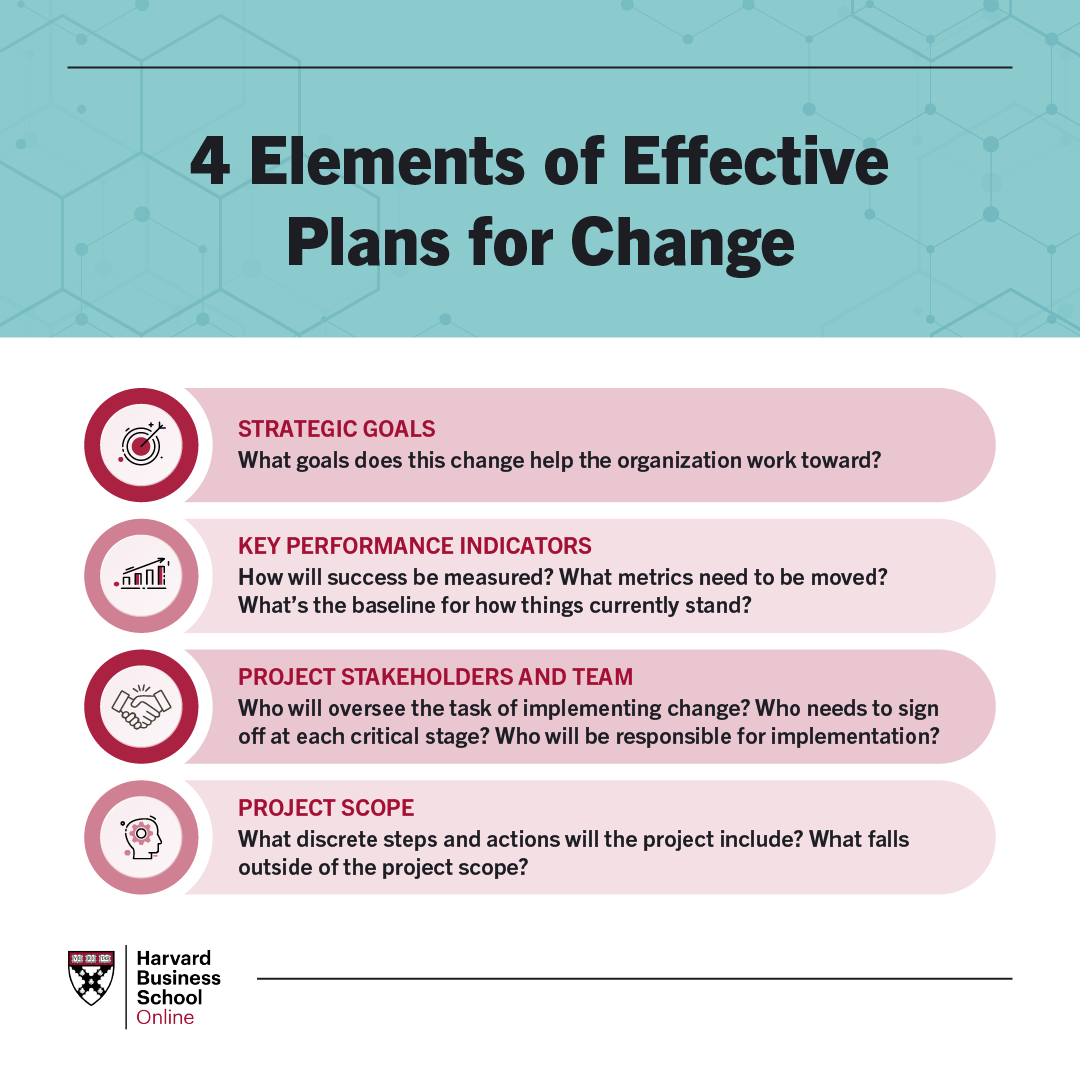
The plan should detail:
- Strategic goals: What goals does this change help the organization work toward?
- Key performance indicators: How will success be measured? What metrics need to be moved? What’s the baseline for how things currently stand?
- Project stakeholders and team: Who will oversee the task of implementing change? Who needs to sign off at each critical stage? Who will be responsible for implementation?
- Project scope: What discrete steps and actions will the project include? What falls outside of the project scope?
While it’s important to have a structured approach, the plan should also account for any unknowns or roadblocks that could arise during the implementation process and would require agility and flexibility to overcome.

3. Implement the Changes
After the plan has been created, all that remains is to follow the steps outlined within it to implement the required change. Whether that involves changes to the company’s structure, strategy, systems, processes, employee behaviors, or other aspects will depend on the specifics of the initiative.
During the implementation process, change managers must be focused on empowering their employees to take the necessary steps to achieve the goals of the initiative and celebrate any short-term wins. They should also do their best to anticipate roadblocks and prevent, remove, or mitigate them once identified. Repeated communication of the organization’s vision is critical throughout the implementation process to remind team members why change is being pursued.
4. Embed Changes Within Company Culture and Practices
Once the change initiative has been completed, change managers must prevent a reversion to the prior state or status quo. This is particularly important for organizational change related to business processes such as workflows, culture, and strategy formulation. Without an adequate plan, employees may backslide into the “old way” of doing things, particularly during the transitory period.
By embedding changes within the company’s culture and practices, it becomes more difficult for backsliding to occur. New organizational structures, controls, and reward systems should all be considered as tools to help change stick.
5. Review Progress and Analyze Results
Just because a change initiative is complete doesn’t mean it was successful. Conducting analysis and review, or a “project post mortem,” can help business leaders understand whether a change initiative was a success, failure, or mixed result. It can also offer valuable insights and lessons that can be leveraged in future change efforts.
Ask yourself questions like: Were project goals met? If yes, can this success be replicated elsewhere? If not, what went wrong?
The Key to Successful Change for Managers
While no two change initiatives are the same, they typically follow a similar process. To effectively manage change, managers and business leaders must thoroughly understand the steps involved.
Some other tips for managing organizational change include asking yourself questions like:
- Do you understand the forces making change necessary? Without this understanding, it can be difficult to effectively address the underlying causes that have necessitated change, hampering your ability to succeed.
- Do you have a plan? Without a detailed plan and defined strategy, it can be difficult to usher a change initiative through to completion.
- How will you communicate? Successful change management requires effective communication with both your team members and key stakeholders. Designing a communication strategy that acknowledges this reality is critical.
- Have you identified potential roadblocks? While it’s impossible to predict everything that might potentially go wrong with a project, taking the time to anticipate potential barriers and devise mitigation strategies before you get started is generally a good idea.

How to Lead Change Management Successfully
If you’ve been asked to lead a change initiative within your organization, or you’d like to position yourself to oversee such projects in the future, it’s critical to begin laying the groundwork for success by developing the skills that can equip you to do the job.
Completing an online management course can be an effective way of developing those skills and lead to several other benefits . When evaluating your options for training, seek a program that aligns with your personal and professional goals; for example, one that emphasizes organizational change.
Do you want to become a more effective leader and manager? Explore Leadership Principles , Management Essentials , and Organizational Leadership —three of our online leadership and management courses —to learn how you can take charge of your professional development and accelerate your career. Not sure which course is the right fit? Download our free flowchart .
This post was updated on August 8, 2023. It was originally published on March 19, 2020.

About the Author
Short Videos on Change Management

Leading provider of teaching materials for management education
Changing well often demands leadership that prepares and motivates employees to retain momentum for change all the while being ready to adjust to surprises. These free videos and readings offer students a glimpse into these key issues about change management.
Short Videos
1 minute, 52 seconds
2 minutes, 23 seconds
2 minutes, 49 seconds
1 minute, 45 seconds
2 minutes, 4 seconds
Supplemental Readings
1117 word count

Related Collections

Introduction to Change Management
The materials in this collection provide students with a grounding in the theory and practice of change management. The cases and simulation help students understand why people may resist change and challenge them to create successful change strategies.
Short Videos on Leading Teams
Teamwork can be complicated while being productive and fun. Good leaders enable diverse individuals to come together to accomplish what they can't individually. These free videos and readings introduce challenging issues managers face when leading teams.
Short Videos on Crisis Management
Managing through a crisis often means doing what doesn’t come naturally. These free videos and supplemental readings can preview students about how to be prepared to lead teams during difficult times.
We use cookies to understand how you use our site and to improve your experience, including personalizing content. Learn More . By continuing to use our site, you accept our use of cookies and revised Privacy Policy .
JavaScript seems to be disabled in your browser. For the best experience on our site, be sure to turn on Javascript in your browser.
Hello! You are viewing this site in English language. Is this correct?
Explore the Levels of Change Management
What is Change Management and How Does it Work?

Tim Creasey
Updated: February 23, 2024
Published: March 31, 2022
Although it is sometimes called the soft side of change, managing the people side of a change is often the most challenging and critical component of an organizational transformation.
Consider a merger or acquisition. The technical side of the change is certainly complex. You must work out the financial arrangements of the deal, integrate business systems, make decisions about the new organization's structure, and more. But getting people on board and participating in the merger or acquisition can make the difference between success and failure.
Why? Individuals will need to perform their jobs differently. The degree to which they change their behaviors and adopt new processes has a significant impact on the initiative. This is why the soft side of change can be the harder side of change. Fortunately, you can apply a structured approach to managing the people side of change and make a big impact on overall success.
Change Management Starter Bundle: S tart applying change management to your projects today with free resources from Prosci.
Download Now
The People Side of Change
Change management addresses the people side of change. Creating a new organization, designing new work processes, and implementing new technologies may never see their full potential if you don't bring your people along. That's because financial success depends on how thoroughly individuals in the organization embrace the change.
Change management is the application of a structured process and set of tools for leading the people side of change to achieve a desired outcome. Ultimately, change management focuses on how to help people engage, adopt and use a change in their day-to-day work.
When defining change management, we recognize it as both a process and a competency.
Change Management as a Process

During Phase 1 – Prepare Approach , we ask and answer:
- What are we trying to achieve?
- Who has to do their jobs differently and how?
- What will it take to achieve success?
During Phase 2 – Manage Change , we ask and answer:
- What will we do to prepare, support and engage people?
- How are we doing?
- What adjustments do we need to make?
And during Phase 3 – Sustain Outcomes , we ask and answer:
- Now, where are we? Are we done yet?
- What is needed to ensure the change sticks?
- Who will assume ownership and sustain outcomes?
Change Management as a Competency
At the organizational level, change management is a leadership competency for enabling change within an organization. It is also a strategic capability designed to increase the change capacity and responsiveness of the organization.
For senior leaders, change management competency means being able to lead change for the organization, including being an effective sponsor of change and demonstrating commitment to the change, both individually and organizationally. For people managers working with front-line employees , competency relates to effectively coaching direct reports through their change journeys. Although competency varies according your relationship to change, organizations are more effective and successful when they build change management competencies throughout their ranks.
Change management is not just communication and training. Nor is it simply managing resistance. Effective change management follows a structured process and employs a holistic set of tools to drive successful individual and organizational change.
Why Do We Need Change Management?
There are numerous reasons to employ effective change management on both large- and small-scale efforts. Here are three main reasons:
Organizational change happens one person at a time
Ignoring the people side of change is costly.
- Change management increases the likelihood of success
It is easy to think about change only from an organizational perspective. When you consider a merger or acquisition, you might focus on financial structuring, data and systems integration, and physical location changes. However, organizational change of any kind occurs one person at a time. That is because an organization-wide change only occurs when Andre, Becky, Carlos and Dharma do their jobs differently.
Organizations don’t change, people do. It is the cumulative impact of successful individual change that brings about successful organizational change. If individuals don’t make changes to their day-to-day work, an organizational transformation effort will not deliver results.
Poorly managing or ignoring the people side of change has many consequences:
- Productivity declines on a larger scale for a longer duration than necessary
- Managers are unwilling to devote time or resources needed to support the change
- Key stakeholders do not show up to meetings
- Suppliers begin to feel the impact and see the disruption caused by change
- Customers feel negative impacts of a change that should have been invisible to them
- Employee morale suffers and divisions between “us” and “them” begin to emerge
- Stress, confusion and fatigue increase
- Valued employees leave the organization
Projects also suffer from missed deadlines, budget overruns, rework and even abandonment. These consequences have tangible impacts on project health and the organization. Fortunately, you can mitigate these issues when you deploy a structured approach to the people side of change.
Change management increases the likelihood success
A growing body of data shows the impact effective change management has on the probability of a project meeting objectives. Prosci’s Best Practices in Change Management benchmarking studies revealed that 88% of participants with excellent change management met or exceeded objectives, while only 13% of those with poor change management met or exceeded objectives.
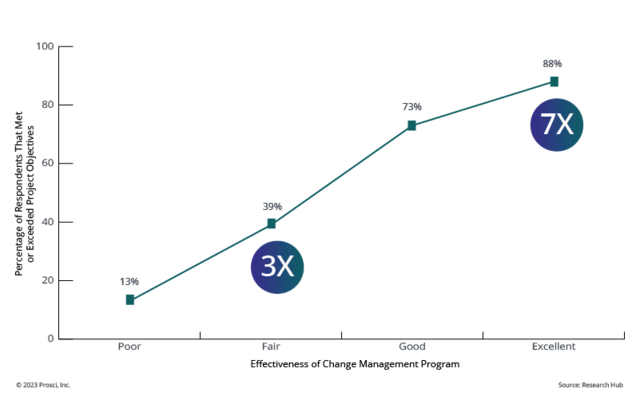
In other words, projects with excellent change management were seven times more likely to meet objectives than those with poor change management. What may be most enlightening about the research is that poor change management correlates with better success than applying none at all.
Prosci research even shows a direct correlation between effective change management and staying on schedule and on budget.
Individual vs. Organizational Change Management
Effectively managing change requires two perspectives: an individual perspective and an organizational perspective.
Individual Change Management
The individual perspective is an understanding of how people experience change. Prosci’s ADKAR Model describes successful change when an individual has:
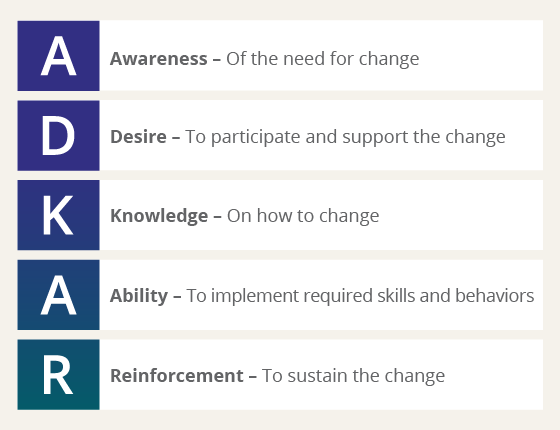
Organizational Change Management
The organizational perspective of change management is the process and activities that project teams use to support successful individual change. If the ADKAR Model describes what an individual needs to make a change successfully, organizational change management is the set of actions to help build Awareness, Desire, Knowledge, Ability and Reinforcement across the organization. The Prosci Methodology is based on more than two decades of research and includes assessments and strategy to support targeted change management plans :
- Master Change Management Plan
- ADKAR Blueprint
- Sponsor Plan
- People Manager Plan
- Communications Plan
- Training Plan
- Resistance Management Plan
- Change Agent Network Plan
- Sponsor Coalition Plan
- Sustainment Plan
- Other custom plans
Change Management Roles
The change practitioner is like the director of the play working behind the scenes to enable actors on the stage. As a change enabler, the practitioner works to develop the change management strategy and plans while supporting and equipping senior leaders and people managers to fulfill their unique, employee-facing roles.
For example, research shows that employees prefer to receive organizational messages about change from leaders a t the top of their organization. And they prefer to receive messages about the change's impact on their day-to-day work from their immediate supervisor .
The practitioner's job is to enable key leaders and people managers to perform these and other employee-facing roles effectively. During times of change, the effectiveness of senior leaders and people managers in these critical roles will determine whether a project or initiative succeeds or fails.
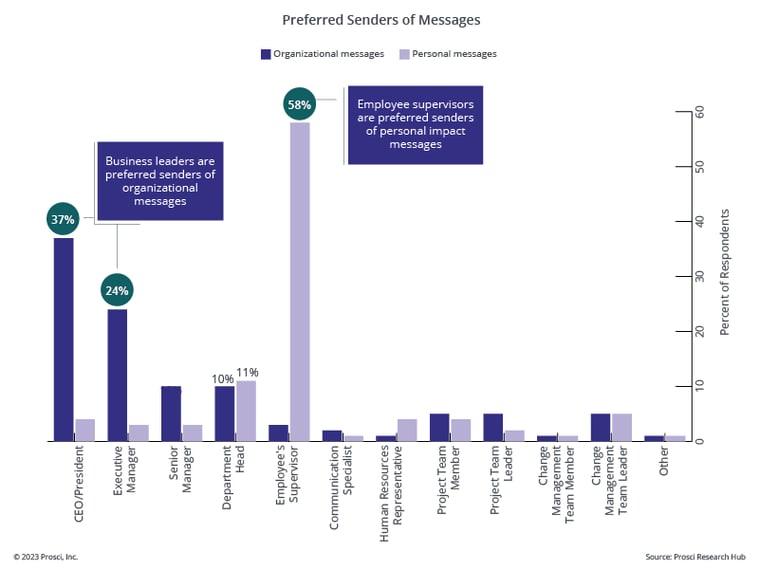
How You Can Effect Successful Change
What can you do to become a more effective change leader? Begin applying change management on your projects and build change management competencies in your organization. These are the first steps to ensuring projects deliver their intended results.
The people side of change is not the soft side of change, it is the harder side of change. Investing the time and energy to manage the people side of your organizational efforts pays off in the end in terms of your effort's success and avoiding the numerous costs that plague poorly managed change.

Tim Creasey is Prosci’s Chief Innovation Officer and a globally recognized leader in Change Management. Their work forms the basis of the world's largest body of knowledge on managing the people side of change to deliver organizational results.
See all posts from Tim Creasey
You Might Also Like
Enterprise - 5 MINS

Expert Interview: The Right Way to Manage Change

Definition of Change Management
Subscribe here.

- Project Management
Home » Free Resources » »
What is Change Management in Project Management?
- Written by John Terra
- Updated on May 14, 2024

When people need to accomplish a specific task or achieve an assigned objective, they typically turn that effort into a project. Organized teams meet and brainstorm the project’s stages, timeline, points, and objectives. By doing this, a team creates an organized plan to help them complete that task or meet that objective. Nothing could be simpler.
However, life is full of surprises, and sometimes, in fact, things change. Perhaps the stakeholders have reduced the deadline or added another objective (or both!!). The project team must be flexible enough to work through the changes in the process, available resources, or personnel and still meet their deadlines. That’s where change management comes in.
This article explores change management in project management. We will define the term, explain its importance, acquaint you with its types and benefits, and compare it to project management and change control. We’ll also share a project management bootcamp for professionals to upskill.
Let’s kick off with a definition. What is change management?
What Is Change Management?
Change management describes the tools and processes a project team uses to manage changes within the project and its team. Change is anything that impacts or alters a project or its tasks, structure, processes, or personnel.
Change management processes typically include a project manager and a dedicated change management team. The project manager oversees the team members’ work to ensure they have successfully incorporated any changes into their practices while achieving the overall project objectives. Team responsibilities usually include communicating with stakeholders, creating training programs, and tracking engagements.
So, change management in project management is a mix of managing change and managing people (e.g., the project teams and stakeholders) to incorporate changes. The process can significantly affect employee motivation and performance.
Also Read: What is Project Resource Management? Everything You Need to Know
Why Is Change Management in Project Management Important?
Change management is essential because project management is a fast-paced process where things can change quickly. Therefore, project managers must be ready to quickly adapt to these unexpected changes accordingly.
It is also necessary to maintain a structured process so team members know how to react to pivot yet stay on the right track to meet their project targets. The Wall Street Journal says, “Good change management can help employees embrace new technologies and directions and keep companies relevant.” When everyone in the organization is aligned on change management, it increases the likelihood of project success.
Here’s a rundown of how it helps various aspects of an organization.
- Day-to-day operations. Change is a constant factor in the daily routine of business operations. These changes might be small, such as a slight adjustment to the team’s workflow, but their impact, when unmanaged, can lead to significant company-wide problems. Daily operations can slow down and become inefficient without an organized, structured approach to managing and communicating changes. Change management helps sustain smooth operations, even during busy times, ensuring that employees understand the established structures and procedures and have the tools needed to adapt, work, and maintain productivity.
- Large-scale transformations. It is also beneficial for larger organizational targets and objectives. Strategic initiatives usually require notable changes to existing systems, processes, or structures. With effective change management, initiatives may succeed and create teams and stakeholders resistant to change or need clarification on how to proceed. By ensuring that changes are suitably explained, understood, and effectively implemented, it can help businesses align workforce capabilities with strategic objectives, creating an environment of shared purpose and engagement.
- Project management. Projects inevitably face change, whether planned or unplanned. These changes can impact project resources, timelines, and scope, resulting in new challenges that must be handled for the project to succeed. Change management offers an efficient, replicable approach to handle these challenges and changes. This approach includes identifying and evaluating the challenges’ potential impact early in the project planning stage, devising strategies to handle them, and communicating with stakeholders to ensure everyone remains on track to achieve the intended outcomes.
- Internal communications. Unchecked change leads to uncertainty and confusion. Thankfully, these changes can be mitigated through clear and effective communication. Organizations can prevent rumors and false information from spreading by regularly updating employees, managers, and stakeholders on any upcoming changes, explaining the reasons behind them, and outlining what these changes mean for everyone, ensuring everyone stays informed and on track.
- Client satisfaction. Maintaining client satisfaction can be challenging in the face of organizational change. Changes can potentially impact product quality, service delivery, customer support, and other essential aspects of the business, leading to customer dissatisfaction. Organizations can minimize these effects by introducing effective change management. Companies can maintain and even enrich customer satisfaction during turbulent times of change by proactively communicating with their customers, managing consumer expectations, and addressing their concerns.
Change Management vs. Project Management
Change and project management processes can try to achieve the same specific outcome, but they approach the task differently.
Project management concentrates on executing a specific assignment with a clearly defined beginning and ending date and specified budget, scope, and resource parameters. It includes planning, organizing, and directing resources (personnel, equipment, and materials) to meet the project goals.
On the other hand, change management is a process designed to deal with any modifications to the organization’s objectives or processes. It can exist under the project management umbrella or stand alone. Change management initiates strategies for controlling, affecting, and helping teams adapt to change.
To frame the comparison in different terms, consider project management as the means of delivering a technical solution on schedule and within its budget, and change management to ensure that any changes within the project or organization will be smoothly implemented while achieving lasting benefits.
For instance, project management could ensure that a company’s cloud migration project is designed to meet the company’s needs and requirements, including cost, anticipated downtime, and timeline. In contrast, change management would train and onboard the company’s staff to use the new system, improve company-wide performance, and develop contingency plans to handle any surprises during the migration process.
Now that we’ve seen how change management and project management differ, let’s see how change management differs from change control.
Also Read: Best Apps for Project Management You Should Know in 2024
Change Management vs. Change Control
Change management and change control both exist to manage change, but they have different focus areas since each affects changes in different project stages.
Change control is the decision to implement a change, while change management is dedicated to the aftermath of the decision. Change control evaluates the incoming change request and decides which to prioritize and proceed with. Change management ensures the personnel affected by the new solution are ready for it, have accepted the change, and know how to work with it.
So, change control is procedural and is typically carried out at the team level. In contrast, change management is strategic and must be approved by upper management or the top management team.
Let’s look at an example.
A project manager receives a change request from a client who wants a new feature added to the mobile app the project team is developing. Since this new feature was never mentioned in the original app’s project scope, the project manager brings the request to the change control team. The change control team typically consists of representatives from contributing teams who are responsible for evaluating these requests.
The change control team evaluates the request by considering vital factors, such as:
- The estimated time and cost of implementing the new feature
- The potential impact on the overall project’s deadline
- The value the new feature would add to the application
- The possible risks associated with adding the requested new feature
After evaluating the request, the team concludes that the new feature would improve the application’s functionality and give the client some added advantage in the marketplace. However, the team also realized that implementing the new change would extend the project timeline and raise costs. The team communicates this to the client before approving the request and adjusts the project budget and timeline accordingly.
The Types of Change Management
Change management in project management comes in several forms, including:
Anticipatory
This type involves planning changes ahead of an expected situation. Once the project manager verifies the likelihood or inevitability of such a change, the team can implement plans for when it inevitably arises. An example could be a client who didn’t factor in different displays for their mobile app. Still, the change management team is smart enough to realize that this feature will inevitably be asked for, so they craft a plan for when the customer approaches them and says, “We forgot about this feature. Can you please put it in?”
Incremental
This process refers to introducing changes gradually over a prolonged period, like adding additional new features to our mobile app example. Since these alterations are minute, they are unlikely to cause any noticeable upheaval in the project timeline. Additionally, incremental changes share a close affinity with scope creep in project management.
Life is unpredictable, so the reactive approach is used when an unforeseen event arises. This type is typically used in crises where there is little reaction time to plan, and the project manager needs to think on their feet. Reactive change management could be better, but it is often necessary.
These changes are significantly larger and can affect the organization’s overall direction. A strategic shift in project management may involve introducing brand-new technology or requiring a significant rewrite of the original project plan.
The Benefits of Change Management
Change management offers plenty to organizations that want to keep up in today’s fast-paced, competitive digital environment. It boosts the odds of a successful project delivery and organizational success by:
- Reducing disruption. Any change in a project can cause disruptions, leading to unexpected problems and even failure. Change management lessens this possibility and ensures that ongoing projects and the organization operate smoothly during and after the changes.
- Promoting acceptance and adoption. It addresses stakeholders’ resistance to changes. This benefit is particularly useful for projects involving changes to processes, workflows, or technologies since these projects are only successful when those affected go along with them.
- Improving team performance. Proper change management is essential for employee performance in individual projects and even entire organizations. It ensures that performance is maintained and improved since employees are supported through transitions.
- Fostering a culture of adaptability . It develops and nurtures a culture of improvement and adaptability. This process contributes to the organization’s longevity by ensuring the company remains open and willing to try new ways of working while keeping processes and capabilities in place to adapt to change without grinding to a halt.
A Change Management Example
Let’s look at a fictitious example. A software company is transitioning from the traditional Waterfall development methodology to a DevOps project management approach. This transition would include how tasks are assigned and tracked, any changes in project team structures, and how outcomes would be delivered. So, effective change management in this scenario would involve:
- Communicating why the transition is happening and the benefits of the DevOps methodology to the team members, appropriate management, and stakeholders.
- Providing the necessary training and support to help the teams adapt to the new way of working
- Establishing new metrics and key performance indicators (KPIs) to track progress and success using the new system
- Continuously monitoring the transition and dealing with any issues or concerns that manifest
We see how mastering change management can help organizations establish a forecasting system and mitigate the unintended adverse effects that typically come with change if they are otherwise unmanaged.
Do You Want Project Management Skills?
If you’re considering a project management career or want to expand your skill set, consider this online project management program . This 24-week bootcamp is aligned with PMI-PMP and IASSC-Lean Six Sigma and imparts valuable project management skills.
Glassdoor.com reports that project managers earn an average of $98,433 annually, and the demand for project managers is consistently high. So, check out this online project management course and get the skills you need to deliver better projects for today’s digital economy.
You might also like to read:
How to Measure Project Success? A 2024 Guide
Remote Project Management: How to Manage Remote Teams Effectively
What are Project Management Skills? Here are Top Skills You should Know in 2024
A Project Management Process Primer
Why Study Project Management? Top 5 Reasons
Leave a Comment Cancel Reply
Your email address will not be published. Required fields are marked *
Recommended Articles

What is Project Scope Management?
This article discusses project scope management, including its definition, steps, process, and importance.

How to Use Microsoft Access: A Comprehensive Guide
Explore the comprehensive guide to Microsoft Access, covering everything from basic functionalities to advanced features. Learn how to use, download, and install MS Access, compare versions, and integrate it with Excel. Ideal for beginners and seasoned users alike.

Unveiling the Project Engineer Job Description: A Comprehensive Guide
Dive into the essential guide on the project engineer job description, exploring roles, responsibilities, skills, and work environment to understand what makes this career pivotal in various industries.

Time Management: Unlocking Your Potential through Effective Planning
Our comprehensive guide will help you discover the transformative power of time management. Learn essential skills, practical tips, and the benefits of effective time management for a more productive, balanced life.

Best Practices in Project Management Office: How to Achieve Peak PMO Performance
Best practices in the project management office help achieve peak performance in project planning and delivery. Learn about the concept, benefits, and top strategies for success.

Top Resource Management Tools in 2024
Are you curious about the best resource management tools in 2024? Get our curated list with detailed insights into features, pros, cons, and pricing.
Project Management Bootcamp
Learning Format
Online Bootcamp
Program benefits.
- 25 in-demand tools covered
- Aligned with PMI-PMP® and IASSC-Lean Six Sigma
- Masterclasses from top faculty of UMass Amherst
- UMass Amherst Alumni Association membership

COMMENTS
Lewin's Change Management Model. This model focuses on helping leaders pursue stages in three phases: Unfreeze — a prep stage, aimed at 'activating' employees to make them more receptive to the imposed changes. Change — the active phase where change is introduced.
Slide 1: This slide displays the heading Change Management with a creative gear image.State your company name below and introduce change management structure. Slide 2: This slide covers Table of Content for the presentation.It includes the following sub headings- Identify the change, vision for change, change management agents and framework, resistance and risk, implementation strategies, cost ...
Phase 2: Manage Change. Next, practitioners develop specific plans to move impacted individuals and the organization through their ADKAR transitions, and learn how to measure, track and adapt performance. This is the longest phase timewise and where the majority of the change management team's work is accomplished:
Create your change management presentation with Prezent. Are you excited to put your newfound knowledge to use? We recommend using Prezent, the all-in-one AI presentation software for enterprise teams. With a library of over 35,000 slides, real-time collaboration, and brand-approved designs from Fortune 500 companies, Prezent can save you up to ...
6. The Project PowerPoint - Change Management PowerPoint. The Project PowerPoint is great for a change management plan. The Project PowerPoint is great for a slideshow with a lot of data. With this models of change PPT, you get many choices to present your data. This management PowerPoint template is a good alternative.
Notable Template Features: This comprehensive template includes slides detailing your organization's change management plan. Enter bulleted data in the table columns for an eight-step plan. Use this template to map change management activities in the 10-month-timeline slide. Prioritize change requests and list each change request's impact ...
Create a sense of action. These change management steps help build teamwork and trust among the employees. The teamwork and trust motivate employees to follow the plan. 4. Deming Cycle or PDCA Cycle. The Deming Cycle, developed by Dr. William Edwards Deming, is also known as the plan-do-check-act cycle.
Impactful change management communication begins with the right slides. Use our Change Management Presentation Template to help your staff, colleagues, and partners prepare for change and embrace it. Build awareness, eliminate stress, and get your employees excited about the future transformation. This template allows you to create an effective ...
Change Management Presentation Template. If you are convincing people of the need for change, use this presentation template. It includes the reasons for the change, the risks involved, benefits and more. The template uses big text, images and icons to help you visually communicate your plan.
Change management plan PPT (PowerPoint) CREATE THIS PRESENTATION TEMPLATE. Consider using Venngage for Execs as an effective change management tool to optimize your change management plan for PowerPoint. Such presentations can be on the lean side, like the one above, giving team members only the basic information they need to get their arms ...
1. Unfreezing. The first stage is unfreezing. Some experts refer to this unfreezing process as getting " unstuck ". The way that you have always done it isn't going to work anymore, so you need to let all that go. Unfreezing means accepting that change is happening and being open to participating in the process. 2.
In both research and practice, we find that transformations stand the best chance of success when they focus on four key actions to change mind-sets and behavior: fostering understanding and conviction, reinforcing changes through formal mechanisms, developing talent and skills, and role modeling. Collectively labeled the "influence model ...
The Lewin's Change Management Model PowerPoint Template is a professionally designed PPT template that can be used to support change management initiatives. This modern PowerPoint template includes a variety of slides that can be customized to fit the needs of your organization.
The Prosci Methodology is one of the most widely used approaches to change management in the world. In fact, Prosci's offices on numerous continents along with over 30 global partners deliver training and support related to the methodology in every corner of the globe. To date, Prosci has certified more than 100,000 practitioners worldwide.
This change management strategy template helps lay the groundwork for your change project before the implementation phase. The template includes a version with sample content that can help guide your team as it outlines its change management strategy. Enter the project, project manager, organization, version, and dates in the fields at the top ...
The first three stages of the change journey ( aspire, assess, and architect) typically take months; the act stage, years. Don't count on the initial excitement to last; instead, generate energy and create ownership methodically to keep your change program on the right path throughout its twists and turns. We often liken the act stage to sports.
Change processes have a set of starting conditions (point A) and a functional endpoint (point B). The process in between is dynamic and unfolds in stages. Here's a summary of the key steps in the change management process. Check out our video on the change management process below, and subscribe to our YouTube channel for more explainer content!
Gain commitment to change management in your organization. by learning to define and speak the language of change management's value. To elicit interest and excitement, you must ground the conversation in your what your audience does and cares about professionally. Start by establishing some easy-to-understand realities of change that you can ...
This toolkit begins with an introduction to the importance of change management and goes over the seven components necessary to effectively manage change. It is organized into four main sections: (1) Change Management Pre-work. (2) Manage Personal Transitions (resistance) (3) Develop Change Plan.
Strategy. Ready for Change. . Organizational Change Management. Organization can drive better performance and amp up business results through effective change management. Leading change is an important part of a leader's job. Resistance from the people who need to change. Navigating the political landscape. Addressing team dysfunctions.
This revision presentation provides an overview of the topic of change management in the context of business strategy. It highlights the main theories on change management including Lewin's Forcefield analysis as well as providing some examples of recent change management case studies Change Management
The Evolving Landscape of Change Management. The PPT framework has existed since the mid-1960s, so many change leaders think that it's no longer useful. The rising use of digital technology makes the PPT triangle heavy on the Technology component, requiring more work on the other components to balance out the triangle.
Short Videos on Change Management. Leading provider of teaching materials for management education. Changing well often demands leadership that prepares and motivates employees to retain momentum for change all the while being ready to adjust to surprises. These free videos and readings offer students a glimpse into these key issues about ...
Change management is the application of a structured process and set of tools for leading the people side of change to achieve a desired outcome. Ultimately, change management focuses on how to help people engage, adopt and use a change in their day-to-day work. When defining change management, we recognize it as both a process and a competency.
Change management ensures the personnel affected by the new solution are ready for it, have accepted the change, and know how to work with it. So, change control is procedural and is typically carried out at the team level. In contrast, change management is strategic and must be approved by upper management or the top management team.
To apply small caps or all caps in PowerPoint, select the text you want to format and click on the "Change Case" button in the "Font" group on the "Home" tab. From there, select either "Small Caps" or "All Caps" from the drop-down menu. Keep in mind that using all caps for a large amount of text can be difficult to read, so ...